 USA (1915) USS Pennsylvania, USS Arizona
USA (1915) USS Pennsylvania, USS ArizonaWW1 US Battleships:
USS Maine | USS Texas | Indiana class | USS Iowa | Kearsage class | Illinois class | Maine class | Virginia class | Connecticut class | Mississippi class | South Carolina class | Delaware class | Florida class | Arkansas class | New York class | Nevada class | Pennsylvania class | New Mexico class | Tennessee class | Colorado class | South Dakota class | Lexington classThe Pennsylvania class were the second class of “standard” US super-dreadnoughts, a simple iteration on the all-of-nothing armour, but innovating as having four triple turrets, and no longer twin turrets on superfiring positions. Their design was repeated on the New Mexico and Tennessee class built during WW1. Present in “battlefield row” in 1941, both were attacked, USS Arizona was blasted by an ammunition magazine explosion, sunk and now a memorial, while Pennsylvania was rebuilt, modernized, and was back in action on 30 March 1942, the first of the “sunken” battleships to be ready for action again. So she had a long career where she took part in the Aleutian Islands Campaign, the Battles of Makin, Kwajalein, Eniwetok, Saipan, Palau Islands Campaign, the landings on Leyte and the Battle of Leyte Gulf, and she fired the last time in anger on another capital ship at the Battle of Surigao Strait.
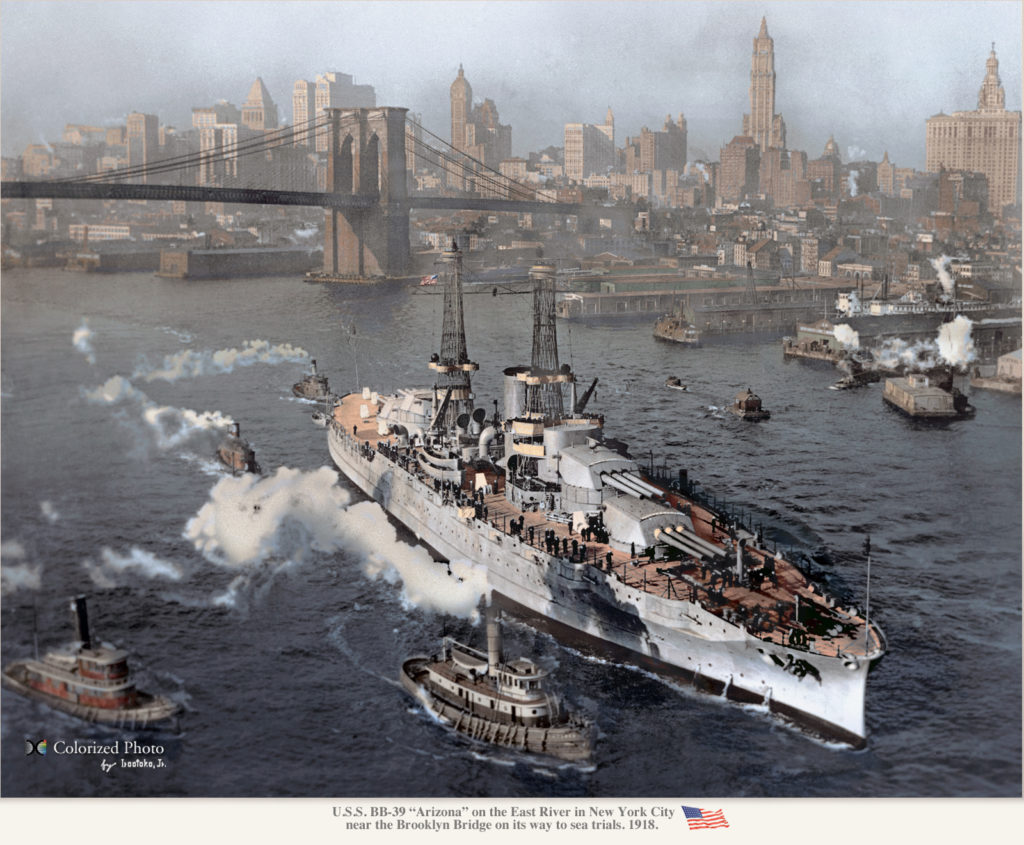
USS Arizona in New York, colorized by irootoko Jr.
Development of the Pennsylvania class
The Nevada-class battleships has been for the USA a great leap forward, even compared to most contemporary foreign designs. They inaugurated the “all or nothing” armor scheme with concentrated heavy armor on vital areas, realizing the emphasis of long range armor-piercing shells and that medium and light armor could only serve to pre-detonate direct contact exploders. This also mean to remove the extra gun turrets by using triple turrets instead, reducing the armoured surface, and thus rationalize even further the concept.
During that conception phase, the Navy’s General Board wanted originally triple gun turrets for all the ship. Even first proposed in American professional magazine of 1901 the concept was only authorized in 1911 and it was still a calculated gamble, with the only dropback of shell interference. The issue was soon fixed by delayed firing for the center barrel, but this made all the difference in the general scheme as dropping an armored barbette and turret benefited to armor protection. The Nevadas also were the first oil-only USN Battleships for better efficiency and reducing bulk space, more rationalization, better range for the Pacific. This however was paid for the Bureau of Construction and Repair (C&R) by a lower center of gravity and higher metacentric height as well as the ASW protection deprived of coal bunkers. It was soon no longer an issue as oil tanks were soon used instead, for an even better result due to the heavy viscosity of oil to absorb a blast.
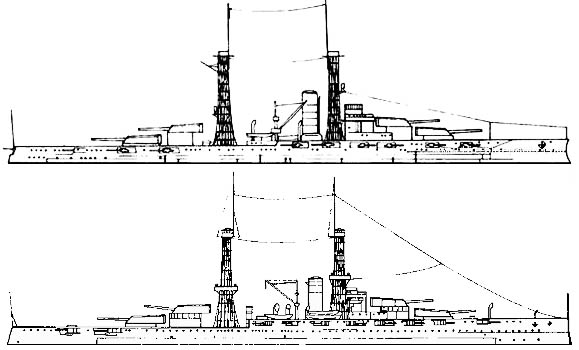
Comparison between the Nevada (top) and Pennsylvania (bottom)
So for the next battleships, to follow the Nevada, the General Board’s FY 1913 design was submitted by June 1911, requesting a repeat of the Nevada, but with a main battery of twelve 14-inch guns in triple turrets, and twenty-two secondary 5-inch guns, always for 21 knots and offering the same level of protection as before. The Bureau of Construction and Repair answered by a first sketch the GB found unsatisfactory as the longer 625 feet (191 m) hull for 30,000 long tons (30,481 t) actually had less armor, using a 12.5-inch (320 mm) belt. The General Board’s specifications then were revised slighty in order to maintain the tonnage as the Nevada class and this process went on with C&R from January to March 1912 thtough thirteen sketches. Reciprocating or turbine engines solutions were also envisioned, notably to deal with the metacentric height. It was calculating notably that by surrendering a half knot freed 500 long tons (508 t) for the belt increased to 15 inches and 14 inches barbettes. In the end, even the triple turrets became an issue in balance, as the Nevada class was still in construction and the concept untested. The Bureau of Ordnance wanted to wait or even leapfrogging directly to 16-inch turrets.
In March 1912, C&R proposed four new designs to GB. The 8 and 9 lowered top speed by 0.5 knots and the 10th stuck with four triple turrets, still 1,200 long tons (1,200 t) lighter than the Nevada-class. In April, the General Board chose the seventh design which had a larger displacement at 31,300 long tons but checked all the boxes. The main armor belt was just below specs at 13.5 inches, and the final design was ready in September, with tests performed in between on the proposed armo, over by in June 1912. Alterations by then were made on the design of was were called now officially the Pennsylvania class. Underwater protection was also revised and tested, including notably the new fuel tanks.
Design of the Pennsylvania class
Overall, the new battleships were longer and larger than the Nevada, with a waterline length of 600 feet (182.9 m), 608 feet overall versus 575 ft/583 ft (175 m), a slightly larger beam at 97 feet (29.6 m) versus 95 ft 2.5 in (29 m) and a draft of 29 feet 3 inches (8.9 m) deeply loaded versus 27 ft 7.6 in (8 m). Standard displacement was 31,400 long tons (31,900 t), 31,917 long tons fully loaded, so 4,000 long tons more and a metacentric height of 7.82 feet (2.4 m).
Propulsion of the Pennsylvania
The Pennsylvania and Arizona were given four direct-drive geared steam turbines, two standard and two cruising ones, driving a 12 feet 1.5 inches (3.7 m) diameter propeller each. These were Curtis models on USS Pennsylvania and Parsons on USS Arizona. These turbines were fed by steam produced in twelve Babcock & Wilcox water-tube boilers. The powerplant was rated for a total of 31,500 shaft horsepower (23,500 kW). However on trials, the yard did not delivered on its promises, as USS Pennsylvania can only reach 29,366 shp (21,898 kW) and just barely exceeded its designed speed at 21.75 knots (40.28 km/h; 25.03 mph) in 1916. USS Arizona was only capable of 21.5 knots (39.8 km/h; 24.7 mph) by September 1924. Both were designed to carry 1,548 long tons (1,573 t) of fuel oil. Their practical maximum capacity in wartime was 2,305 long tons. Fully loaded to this capacity they could cruise at 12 knots (22 km/h; 14 mph) over 6,070 nautical miles (11,240 km; 6,990 mi), extended up to 7,585 nautical miles (14,050 km; 8,730 mi) with a freshly cleaned bottom. In addition, onboard electrical power was provided by four 300 kw (402 hp) turbo generators.
Armament
Main:
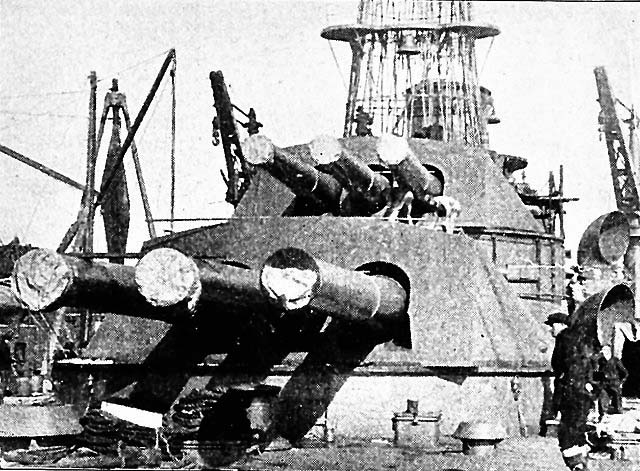
Both battleships carried a main battery of twelve 14-inch/45 caliber guns. This was the advantage of one twin turret over the previous Nevada class. This was only possible by having superfiring triple turrets. This was at the time of their conception a gamble, as the previous Nevada were still in construction. Also to limit possible weight problems, compromises were made in the turret and mount design:
-The guns could not elevate independently
-The mounts were limited to +15° elevation
This allowed a maximum range of just 21,000 yards (19,200 m). 100 shells were procured for each gun, so 1,200 in all, of AP and HE types. The 14″/45 caliber gun was introduced back on the USS New York-class and previous Nevada class. The Mark 1 had an A-tube without liner, with a jacket and eight hoops plus screw box liner reinforced by four hoop-locking rings. The Mark 3 had three more hoop locking rings plus a longer slide, and the Mark 5 five hoops. Interchangeability was high, allowing improved Marks to be fitted after the barrel’s life with ease. These 14-in had a long service, they were also used by British monitors in WW2 as BL 14 inch gun Mk II. For more information, see the WW1 USN Battleships page artillery section.
Secondary:
Close defense against torpedo boats was assured by a battery of twenty-two 5-inch/51 cal. guns. They were all mounted in hull’s sides individual casemates. This solution soon appeared less than idea, quite vulnerable to sea spray and therefore unusable in heavy seas. They could elevate to 15°, procuring a maximum range of 14,050 yards (12,850 m). Each was supplied by 230 AP shells, to 5060 for the whole ship. The 5″/51 (12.7 cm) of Marks 5-10 had been used from the USS Florida (B-30) to the Colorado (BB-45). Armor penetration on average was around 3,200 yards (2,930 m) for 102 mm down to 51 mm at 8,000 yards (7,320 m).
Tertiary:
The ships also had four 3-inch (76 mm)/50 caliber specifically for anti-aircraft (AA) defense, but two as completed, the remainder added afterward, and placed on the roof of ‘X’ Turret. For close range, these battleships did not derogated to the rule of having two submerged 21-inch (533 mm) torpedo tubes, with a provision of 24 Bliss-Leavitt Mark 3 torpedoes. Needless to say they were removed during their first interwar modernization.
Armour protection
The Pennsylvania-class re-conducted the innovative all-or-nothing scheme of the Nevadas, with armor on the most vital areas. The waterline armor belt had Krupp armor at 13.5 inches extending over the machinery spaces and magazines, on 17 feet 6 inches (5.3 m) in height. 8 feet 9.75 inches (2.7 m) of this was actually below the waterline. This armor belt also tapered to its minimum thickness of 8 inches from below the waterline up. Transverse bulkheads closed the citadel, the thickest having 13 inches at the thickest, down to 8 inches. Main turret faces had 18 in armor (457 mm) down to 9–10 inches (230–250 mm) for their side and 5 inches for their roof. Barbettes were protected by 4.5 inches to 18 inches (114 to 457 mm). The conning tower had 16 inches (406 mm) walls, and was topped by a 8 in roof.
The main armor deck saw the assembly of three separate plates bringing the total to 3 inches. Over the steering gear the thickness went up to 6.25 inches (159 mm) with two plates. The splinter deck ranged from 1.5 to 2 inches (38-51 mm) in between the plates. There was also a conical mantlet wrapped around the boiler uptakes, 9 to 15 inches (230 to 380 mm) thick. For ASW protection, there was a longitudinal 3-inch (76 mm) torpedo bulkhead, 9 feet 6 inches (2.9 m) far from the hull’s side, full compartimentation with oil tanks and complete double bottom. The assembly was tested by constructing a replica of a section of the hull for underwater tests performed by mid-1914. They showed this system could withstand a 300 pounds (140 kg) TNT warhead blast.

Pennsylvania class specifications 1916 |
|
| Dimensions | 185.3 m oa x 18.9 m x 6.3 m (608 x 97 x 29) |
| Displacement | 29,158 long tons standard, 31,917 long tons FL |
| Crew | 55+860 |
| Propulsion | 4 shafts Parsons/Curtis turbines, 12 Admiralty boilers, 31,500 shp. |
| Speed | 21 knots, Range 6,070 nm (11,240 km) at 12 knots. |
| Armament | 4×3 14-in (340 mm), 22 x 5-in (127 mm), 4 x 3-in AA (75 mm), 2 TT 21-in sub. |
| Armor | Belt: 8–13.5 in (203–343 mm), Bulkheads: 13–8 in (330–203 mm), Barbettes: 13-8 in, Gun turrets: 18–5 in (457–127 mm), Conning tower: 16 in (406 mm), Decks: 1.5–3 in (38–76 mm) |
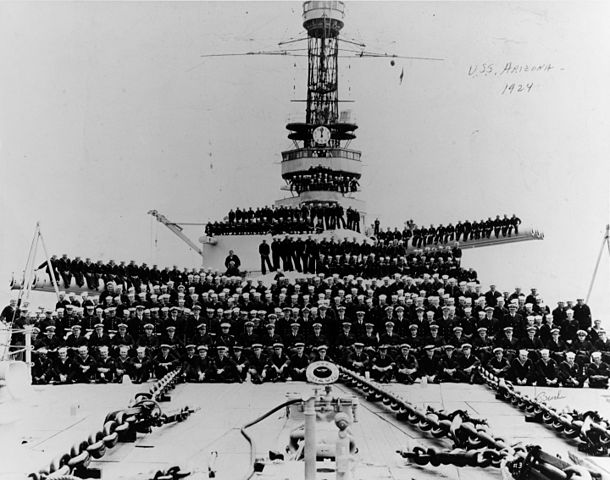
USS Arizona’s crew
Construction
Authorization for the new ships faced political opposition, some Senators like Benjamin Tillman arguing it was too weal to face new constructions in Europe and also that the cost was prohibitive since between 1907. Tillman went on to propose a “maximum battleship” in a Senate resolution in July 1912. Maximum size, draft, armament, armor were to be fixed in relation to taxation for naval supremacy. The C&R already completed studies based on serious limitations already but despite of this, political opposition in Congress made it difficult to vote the Pennsylvania class. The House of Representatives rejected to fund the ships FY1913, unlike the Senate. Compromise was found on one battleship only. Authorized came at last on 22 August 1912. Plans were submitted to all shipbuilders on 20 December, proposals opened on 18 February 1913, and the contract awarded to Newport News on 27 February 1913. This was the lowest bidder, at $7,260,000 without armor or armament. Final cost was to be $7,800,000, and $15,000,000 total with armor and armament.
USS Arizona (BB39) was approved for FY1914. However secretary of the Navy George von Lengerke Meyer requested three battleships that year to maintain the policy of two BBs per year, but congressional opposition led to only one authorized, on 4 March 1913, although it was ordered earlier, on 24 June as the usual procedure was eliminated by giving it directly to a navy-owned shipyard, New York Naval Shipyard.
USS Pennsylvania was laid down on 27 October 1913. The scheduling states 14 months until launch, 32 until completion. USS Arizona (still not named when was laid down) was started on 16 March 1914, Franklin Delano Roosevelt was present when the first piece of the keel was placed. The Navy builder wanted to establish a world-record, with just 10 months until launch. These speeds has been also advocated by Navy Secretary Josephus Daniels, which wanted to compete with British and German shipbuilding. Goals were not met in the end, between a launch on 16 March 1915 (17 months) and Arizona on 19 June 1915 (15). Her launch was filmed, for archives and study it to help for future launches. Fitting-out and sea trials followed, showing some slight improvement over the designed speed, at 21.75 knots. The Navy’s Board of Inspection found it sufficient enough, whereas but the review Scientific American deplored this compared to European “greyhounds” such as the Andrea Doria and Gangut class, or the British Queen Elizabeth which were comprised between 22.50 and 25 knots.
1930 Reconstruction
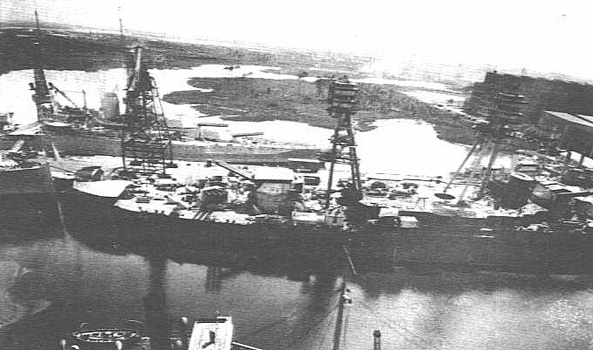
From 1st of June 1929, USS Pennsylvania was taken in hands at Philadelphia Navy Yard for a major refit and modernization, which lasted until the 1st March 1931. USS Arizona was first, at Norfolk Navy Yard between April 1929 and 19 March 1931, starting her post-refit sea trials.
-Deck and turret roof armor increase
-Anti-torpedo bulges added
-New turbo-generators, turbines, and six three-drum Bureau Express boilers.
-New cradles for the main battery, 30° elevation
-Secondary battery reduced to 12
-Eight 5-inch/25 AA guns added
-Torpedo tubes removed
-Lattice masts changed for tripod masts.
-Bridge enlarged and rebuilt with and admiral bridge as flagship.
-Modernized FCS and ballistic computer
-Living space increased
-Crew now 2,037 crew plus a marine company
-Two catapults and 2 seaplanes for observation and spotting
Pennsylvania class specifications 1930 |
|
| Dimensions | Same but 32.4 m wide. |
| Displacement | 34,400 long tons standard, 39,224 long tons FL |
| Crew | 950 |
| Propulsion | Same but 6 Bureau Express boilers, 31,500 shp. |
| Armament | Same but 12 × 5-in + 8 × 5-in AA, 8 × 0.5 M2HB HMG, 3 planes |
| Armor | Same but ASW bulges, turret roof |
Reconstruction and modernization, USS Arizona as of 1941
The loss of Nevada left only Pennsylvania in her class, to see the rest of WW2. In drydock during the attack, and not in the “row” she was only slightly damaged, and on 12 December was refloated and towed out of the drydock and after supplies and examination by divers, she was sent out at, departed Pearl on 20 December to rally San Francisco’s drydock, Hunter’s Point on 1 January 1942, repaired until 12 January. Until August she returned to Mare Island Naval Shipyard, San Francisco to receive armament and sensors updates (radar). The additional AA made her heavier.
USS Pennsylvania, Repairs and modernization 1942
Pennsylvania class specifications 1942 |
|
| Displacement | 36,500 long tons standard, 40,000+ long tons FL |
| Electronics | CXAM-1 Radar |
| Armament | Same but 16 × 5-in/38, 40 × 40 mm Bofors, 51 × 20 mm Oerlikon AA |
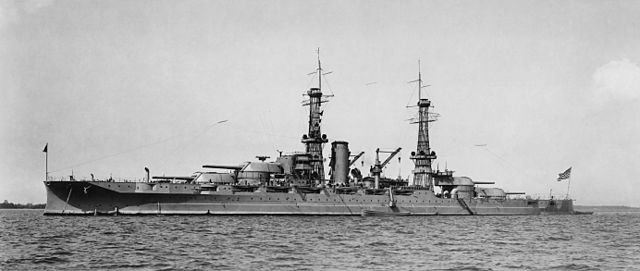
USS Arizona underway in the 1920s
Read More/Src
J.Gardiner, Conway’s all the world’s fighting ships 1906-1921 & 1922-1947
“Arizona.” Dictionary of American Naval Fighting Ships. Naval History & Heritage Command.
“Pennsylvania.” Dictionary of American Naval Fighting Ships. Naval History & Heritage Command.
“Battleship Pennsylvania.” Journal of the American Society of Naval Engineers
Barber, G.H. “Launching of the Battleship Arizona,” International Marine Engineering 20, no. 8
Breyer, Siegfried. Battleships and Battle Cruisers, 1905–1970. Translated by Alfred Kurti.
Campbell, John. Naval Weapons of World War II. Annapolis, MD: Naval Institute Press
Cates Junior, Clifton B. War History of the USS Pennsylvania BB (38). N.p.: Ship’s Welfare Fund
Friedman, Norman. Battleship Design and Development, 1905–1945. New York: Mayflower Books
US Battleships: An Illustrated Design History. Annapolis, MD: Naval Institute Press
Gill, C.C. “‘Pennsylvania’ Trials.” Proceedings 42, no. 2 (1916)
Jones, Jerry W. US Battleship Operations in World War I. Naval Institute Press
McCarthy, J. Crosby. “Launching a Giant Battleship a Long-planned and Risky Job.” Popular Mech.
“Recent Launches.” International Marine Engineering 20, no. 4 (1915)
Stillwell, Paul. Battleship Arizona: An Illustrated History. Naval Institute Press
Tillman, Benjamin Ryan and William Adger Moffett. Construction of Battleships.
“Trials of the Battleship Pennsylvania.” International Marine Engineering 21
“The Tillman Maximum Battleship.” Advocate of Peace 74, no. 7
“The United States Battleship ‘Pennsylvania’ and Class.” Scientific American 111
“Trials of Our Latest Dreadnought.” Scientific American 114, no. 12
Whitley, M.J. Battleships of World War Two: An International Encyclopedia. Naval Institute Press
Wright, Christopher C. “The US Navy’s Study of the Loss of the Battleship Arizona”. Warship International
https://www.history.navy.mil/our-collections/photography/us-navy-ships/battleships/pennsylvania-bb-38.html
https://www.history.navy.mil/our-collections/photography/us-navy-ships/battleships/arizona-bb-39.html
http://www.navsource.org/archives/01/38a.htm
http://www.navsource.org/archives/01/39a.htm
https://en.wikipedia.org/wiki/Pennsylvania-class_battleship
https://en.wikipedia.org/wiki/Nevada-class_battleship
https://www.the-blueprints.com/search/Pennsylvania/
http://www.navypedia.org/ships/usa/us_bb_pennsylvania.htm
The model’s corner:
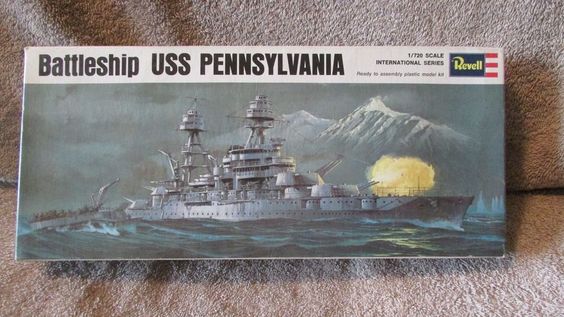
-Revell’s Pennsylvania 1/720 1942 (1968)
-Dragon Pennsylvania 1/700 1942
-DML Pennsylvania BB-38 1944 1:700 1944
-Hobby Boss HY86501 USS Arizona BB-39 1/350
-Gold Medal Pennsylvania class 1/350 photo-etch
-Revell 1:426 USS Arizona Battleship (toy)
-TRUMPETER USS Arizona 1:200 Scale
-Metal Hearth 3D uss arizona 1931
-Hobby Boss USS Arizona 1/700 1941
-USS Arizona 1941 paper kit 1/200
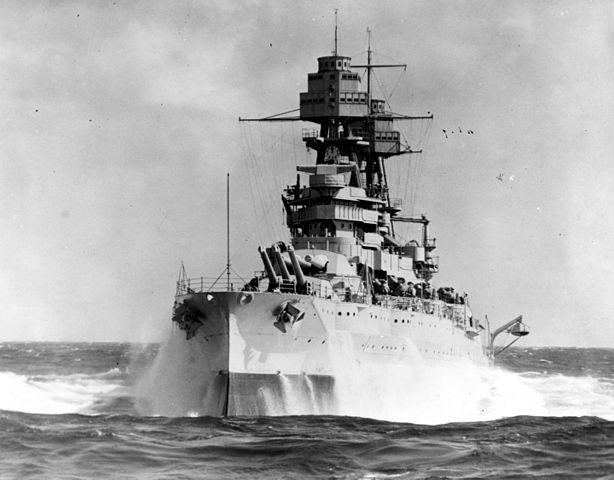
USS Arizona in rough seas after reconstruction in the 1930s
The Pennsylvania class in service
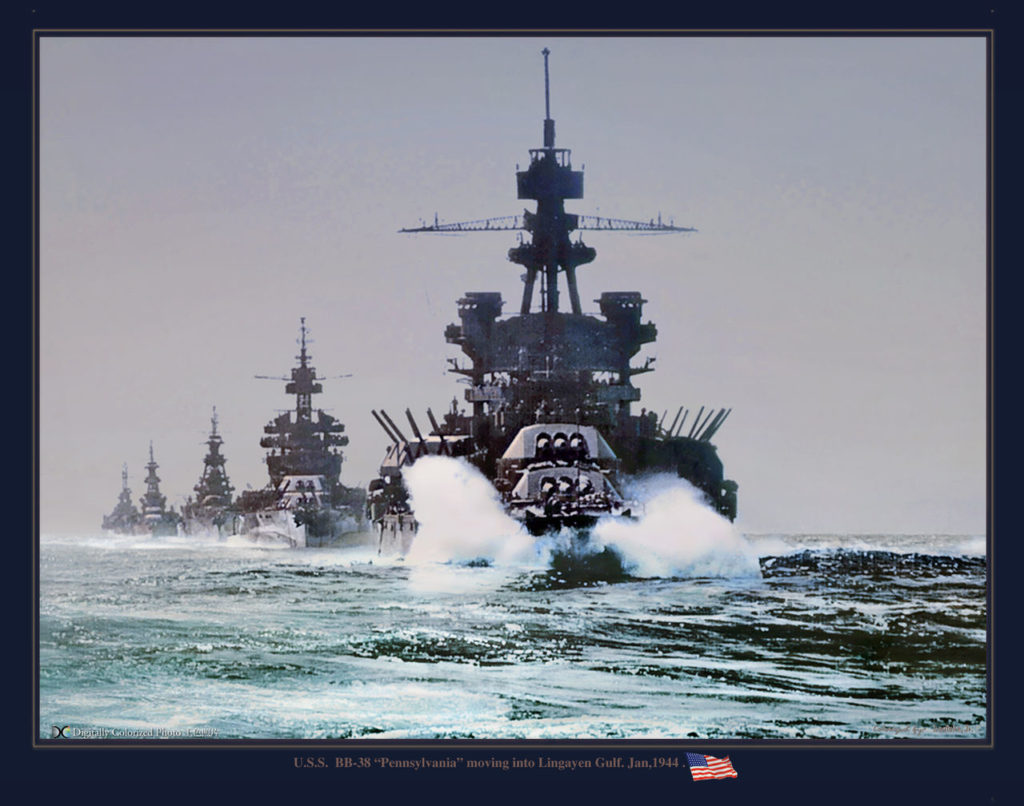
Both battleships had a relatively quiet interwar service, in the Atlantic and Pacific. In Pearl Harbor on 7 December 1941, on was in the battleship row, USS Arizona, and the other was in drydock. So their fate was quite opposite: Nevada became a symbol of the sheer destruction in Pearl, while Pennsylvania emerged unscathed and was soon back into the Fray in January 1942. She had perhaps the longest career among these pacific battleships.
USS Arizona
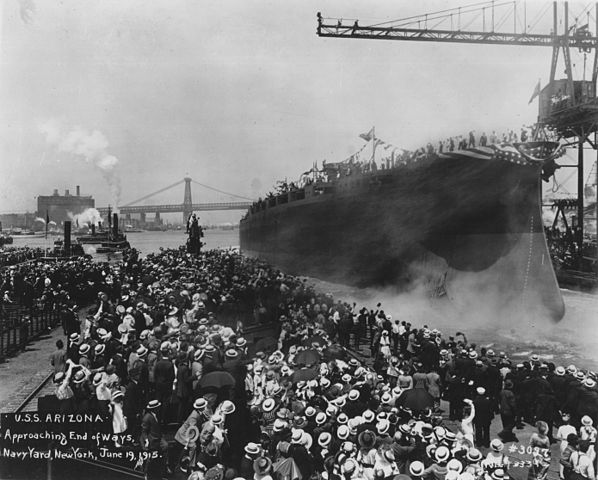
Launch preparations of Arizona.
The second battleship was announced to be built in a navy yard and in a world record time until the launch in 10 months. The New York Times at the time declared it would be “the world’s biggest and most powerful, both offensively and defensively, superdreadnought ever constructed”. In reality construction progressed much more slowly, and she was launched on 19 June 1915 aft 15 months instead, renamed after by Secretary of the Navy Josephus Daniels, 75,000 people attending the launch day. The mayor, the governor of Arizona, and high-ranking military officials were there as well as Florida, Utah, Wyoming, Arkansas, New York, and Texas which were gathered to make a honor guard and gun salute the new battleship. She was commissioned on 17 October 1916, John McDonald was her first captain. She departed New York in November, passed a degaussing to enable her magnetic compasses, and sailed south for her shakedown cruise. Off Cuba she had turbines problems, and was ordered back to New York to manage the issue, and later made her first gunnery exercise in the Chesapeake Bay in December. The complete replacement of the turbine was a long and difficult operation and she emerged in April 1917 from the yard. By that time, the US was at war. But like her sister-ship Pennsylvania she was not sent to Battleship Division 9 as working on coal. Instead she spent her time in exercises along the east coast, generally the Caribbean in summer, and stops at NYC for maintenance. Also eight of her 5-inch guns were removed to equip AMCs, those most exposed to heavy seas. Also she rarely ventured into the ocean for fear of U-boats, but under ASW escort.
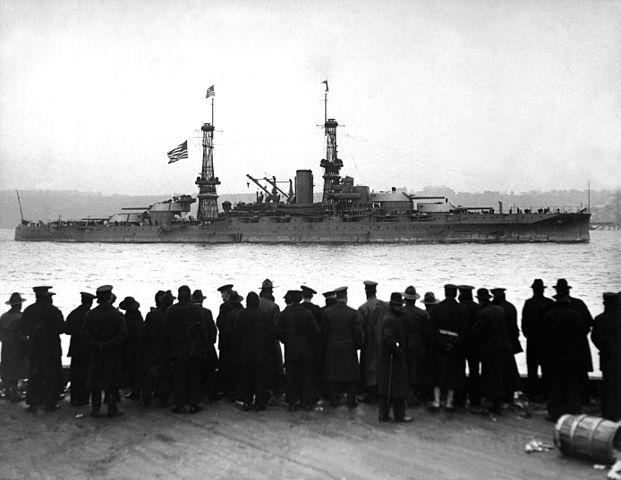
USS Arizona in 1918, for the naval review in New York following victory celebrations.
After the war ended, her interwar career started and went on in a similar way as the Pennsylvania, but contrary to her she was rarely used as flagship. Like her sister-ship she escorted President Woodrow Wilson on SS George Washington to Brest, and was back to NYC for victory celebrations, crowned by a large fleet review. In 1919 she was sent to Smyrna (now Izmir) in Turkey during the Greco-Turkish war. She in York Navy Yard on 30 June for an overhaul, and made her first trip to the Pacific via the Panama Canal in January 1921. The following years there were rather dull, described by Paul Stillwell as “including a great deal of sameness and repetition”. She had another captain in 1923 the ship, John Y.R. Blakely. She paticipated to Fleet Problem IX in January 1929 before joining Norfolk Navy Yard for her major modernization. She emerged to start her post-reconstruction sea trials 19 March 1931 at Rockland, Maine, and transferred to the west coast for exercizes and back to the east coast, culminating with the Fleet Problem XIV in 1933. The next year she hosted a movie with James Cagney for Warner Brothers “Here Comes the Navy”. She collided during the filming with a fishing trawler, leading to an enquiry.
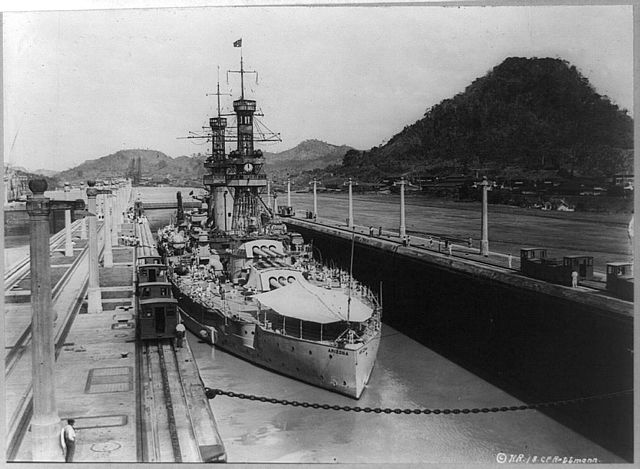
Through the Panama canal in 1921
After Captain George Baum took command, USS Arizona was sent training on the west coast, where she became for a short time flagship for Rear Admiral Samuel W. Bryant in September. She particopated in Fleet Problem XVI in 1935 and Fleet Problem XVII in 1936, her new captain George A. Alexander taking command, and as flagship, hosted Rear Admiral Claude C. Bloch. However the exercises were cut short by a turret accident on 24 July that year. Bloch was replaced on 2 January 1937 by Rear Admiral John Greenslade, and later Rear Admiral Manley H. Simons, USS Arizona spent 1937 without notable event, participating in Fleet Problem XIX off Hawaii in 1938, while captain Kidd took command, and later Rear Admiral Chester Nimitz took the head of the division, relieved in 1939 by Rear Admiral Russell Willson. Her last fleet exercize went on April–May 1940 and she was sent to Pearl Harbor as war raged in Europe and tensions rose with Japan. In betwee she was overhauled a last time at the Puget Sound Navy Yard in Bremerton (Washington) October 1940-January 1941. She had a search radar added atop her foremast, and new AA directors plus mounts for M2 Browning AA MGs.
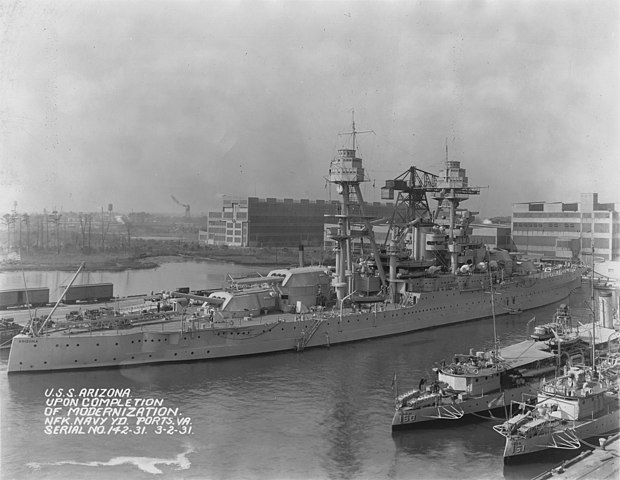
USS Arizona Circa 1932 or 1933
In December 1941, USS Arizona was in battleship row, still a division flagship, under command of her former captain, Isaac Kidd, now a rear admiral, and Captain Harold C. Train and later Franklin Van Valkenburgh her last captain. Her last exercize on 4 December was a night manoeuver with Battleship Division One, USS Nevada and Oklahoma. On 7 December, Arizona was posted behind Nevada, alone along the berth. So she was not shielded from her left side. The ship’s air raid alarm started at 07:55, and general quarters was signalled, just when at 08:00, ten Nakajima B5N2 “Kate” torpedo bombers, attacked Arizona with bombs. These were 410 mm (16.1 in) AP shell converted as bombs with 797 kg (1,757 lb) warheads, dropped from 3,000 meters (9,800 ft) in straight flight. They fell from amidships to stern, and bow shortly after. These planes came from kaga and Hiryu.
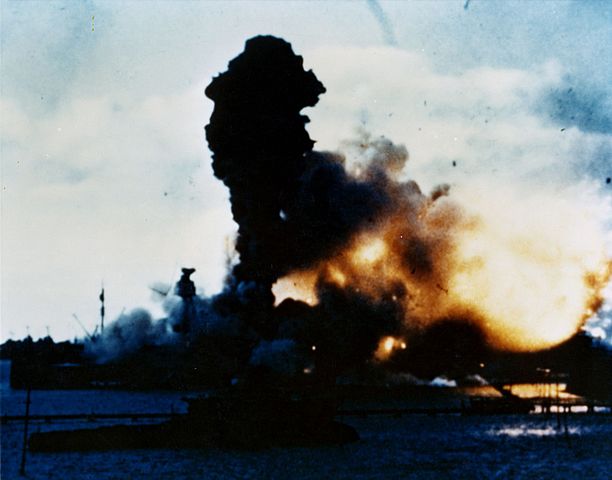
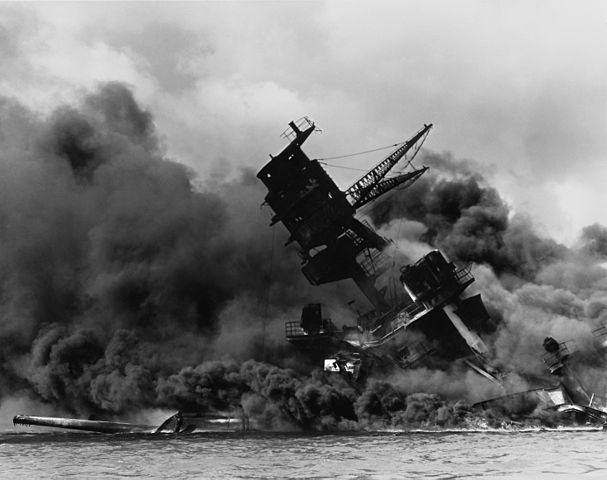
The explosion and burning wreck two days after
Four hits and three near badly shaken the Arizona, with a port bow near-miss being particularly violent, thought to be a torpedo hit. Surprisingly, the first three proper bombs hits cause moderate damage. The sternmost hit ricocheted and penetrated the deck, ending in the captain’s pantry. Another hit the port edge abreast the mainmast, and detonated approximatively close to the anti-torpedo bulkhead. Another struck near the port rear 5-inch AA gun, but the last one was fatal for the Battleship. It fell near Turret B, penetrating the armored deck and ended in the forward main ammunition magazine. These bombs had a delayed fuse, and this one exploded seven seconds after the hit. There was little to do to avoid the consequences but flooding the magazine. Instead the forward magazines detonated in what rocked the entire base at Pearl Harbor. It was heard in all the Island and far in Hawaii. The explosion vented through the sides, destroying all the interior structure and ejected Turret B from its barbette. After the ship bulged upwards in adramatic fashion, it collapsed downward about 25–30 feet (7.6–9.1 m), the foremast and funnel following, and effectively broke in two. Fires burned for two days while debris showered on all Ford Island and beyond. The blast ignited the nearby the repair ship USS Vestal moored alongside, which sank afterwards. This particular hit killed 1,177 crewmen (for 1,512), many lost in the werckage of the sinking halves.
This tragedy was probably the most recoignisable horror of the attack, abundantly showcased in movies and photos, symbolozing the attack on pearl Harbor as a whole. An enquiry in 1944 concluded improper storage of black powder and open hatch (to left a flash to pass) were likely to have cause the explosion. Medals of Honor were distributed among suvivors for acts of gallantry amidst the fire, for their quick actions, evacuating other sailors and quelling fires and the ship earned a battle star. Rear Admiral Kidd was killed in the explosion, the first high-ranking officer lost in this war for the USA, as well as captain Valkenburgh. USS Arizona was placed in “ordinary” service, until stricken from the Naval Vessel Register on 1 December 1942 and her surviving hull and structures scrapped that year to clear up the area. However the bottom stayed where it was. Her main after turrets were removed and the guns ended at the US Army Coast Artillery Corps Battery Arizona at Kahe Point, but what was left of the forward section was left there, but guns salvaged, replacing older barrels from USS Nevada. The remains became the USS Arizona Memorial, in partial commission contrary to the USS Constitution. In 1962 a memorial was built over the remains, still a tourist attraction in Oahu. The Navy now awards every two years “The USS Arizona Memorial Trophy” for combat readiness.
USS Pennsylvania
From 1st commission to 1924
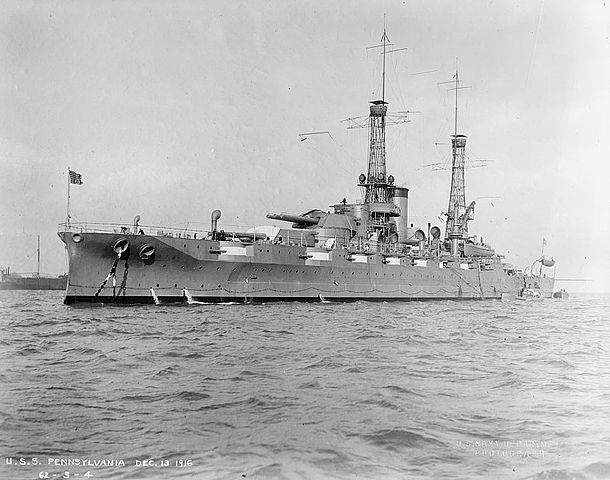
USS Pennsylvania as completed in 1916, official USN ordnance photo
As work was completed by mid-1916 at Newport News, Virginia, she was commissioned on 12 June, under command of Captain Henry B. Wilson. Assigned to the Atlantic Fleet, her post-trials fitting out lasted until 20 July. Her definitive sea trials took place from there, off the Virginia Capes, up to New England. She was visited on 21 August by Rear Admiral Austin M. Knight and Naval War College’s officers, to observe fleet training exercises, and later by Franklin Delano Roosevelt, Assistant Secretary of the Navy. She became flagship of Rear Admiral Henry T. Mayo on 12 October, and in December, sent into drydock at the NY Navy Yard for maintenance, out in January 1917 to join fleet exercises in the Caribbean Sea. On 6 April she was back in Virginia when the United States declared war on Germany. As she was oil-fired, and the British had mostly coal supplies, she never joined Battleship Division Nine at Scapa, and stayed in home waters doing exercises and patrols. There was a naval review for President Woodrow Wilson, foreign naval officers visits, fleet and gunnery training in Chesapeake Bay, Long Island Sound, night battle training. In November 1918, Armistice came and she returned in the New York Navy Yard for maintenance, until 21 November. She escorted the President’s ship to Brest, France in December for peace negotiations and later victory celebrations.
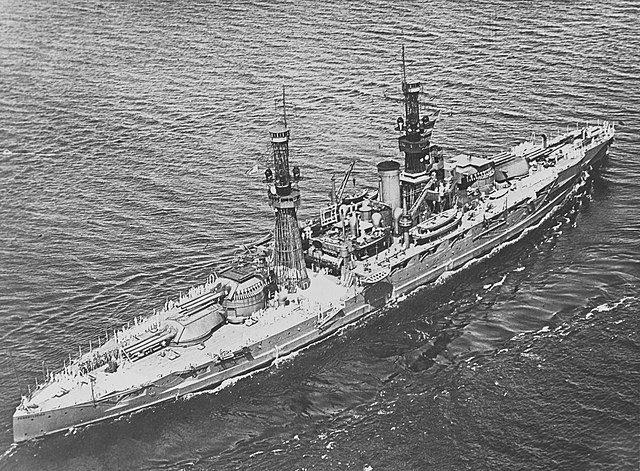
USS Pennsylvania in 1920, aircraft view
On 19 February she joined the Caribbean for exercises, was back in New York on 14 April until June, Vice Admiral Henry Wilson taking command as her as flagship of the Atlantic fleet. On 8 July she stopped at Tomkinsville, to board an important state delegation, which cruised back to New York, making more Caribbean training in 1920, and back to NYC. On 17 July 1920 she was now renamed BB-38 in the new USN nomenclature. On 17 January 1921, she joined the Pacific Fleet via panama, now re-designated the “Battle Fleet”, as its flagship. On 21 January, this new battle fleet left Balboa to Callao, Peru, and back to Balboa on 14 February. She participated in maneuvers off Cuba in the winter, and in April was in Hampton Roads, Virginia, to be visited bt President Warren G. Harding, with state naval heads, Denby, Roosevelt Jr. and Admiral Robert Coontz (CNO). After the Caribbean, and a New York maintenance, she was sent in Plymouth, Massachusettsand back in drydock until 20 August. She transited in the Pacific, at Balboa and then San Pedro, California, and in 1922 visited ports along the US west coast before a refit at Puget Sound Navy Yard. She won the Battle Efficiency Award that year. That same year she sailed back via Panama to Culebra before returning to San Pedro and from May 1923, resuming ports visits until the end of the year, and was in Puget Sound until 1st March 1924.
From 1924 to Reconstruction

USS Pennsylvania in Australia in 1925
USS Pennsylvania was in San Francisco to supply before joining the Battle Fleet in San Diego in March, cruising in the Gulf of Fonseca, and to Limon Bay in the Atlantic, visiting ports in the Caribbean. Back in San Pedro until June, she sailed to Seattle as the flagship of Battle Division 3 (Battle Fleet), taking part in training exercises until September. She trained with the coastal defences around San Francisco and was overhauled in October 1924 and December 1924 to January 1925, and again to Puget Sound 25 January-24 March. Back to San Pedro and San Francisco she sailed to Hawaii for exercises, and started a cruise in the Pacific, down to Australia on 22 July. She also visited Wellington in New Zealand, until 22 August. Back home, she stopped in the American Samoa and Hawaii. After gunnery practice 5-8 October, she was idle until the end of 1925. In 1926 she sailed to Balboa for more exercises, until 27 February and was refitted from March to 14 May, stopping at San Pedro and touring west coast ports until September. She remained there until 11 January 1927, had another refit on 12 March. Joining training exercises off Cuba on 17 March she crossed the canal to Guantanamo Bay and in April, left Cuba to visit Gonaïves in Haiti, then back to New York on 29 April. She served in Balboa until June, San Pedro, and touring the west coast. Her Puget Sound refit started in April 1928 and lasted until 16 May. She later visited Victoria in British Columbia, then back to San Francisco, visiting ports in June later carrying Secretary of War Dwight F. Davis to Hawaii. The USN Battleship was in Seattle on 26 August.
After her Caribbean training session from January 1929, she was sent to Philadelphia Navy Yard, arriving on 1st June for a major refit and complete modernization (see notes earlier). Back in service on 1st March 1931, she did post-refit trials in Delaware Bay March-April 1931, and steamed south to Cuba in May for training and same in July-August, after which she departed for the pacific Battle Fleet in San Pedro. From January 1932 she visited several west coast harbours, and was in Pearl Harbor on 3 February to take part in Fleet Problem XIII. Back to San Pedro on 20 March, up to April, she then cruised along California, before being put in pre-reserve in San pedro.
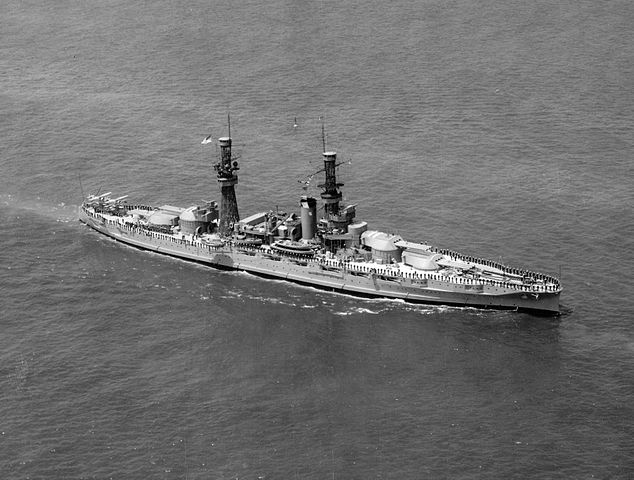
USS Pennsylvania in the 1927 naval review
From 1932 to War
On 9 February, USS Pennsylvania too part in Fleet Problem XIV, until the 17 and was back to San Pedro via San Francisco, remaining here until 19 June idle. She made another west coast cruise until 14 November, and stayed inactive until March 1934. After a short sortie at Hunters Point Naval Shipyard she participated in Fleet Problem XV in the Caribbean, sailing across the canal, until 12 May, and to the Gonaïves and New York where a naval review for Franklin D. Roosevelt took place. On 15 June, Admiral Joseph M. Reeves raised his mark on USS Pennsylvania, as fleet flagship. On 18 June, the battleship returned to the Pacific, via Hampton Roads and the canal, arriving in San Pedro on 7 July, and Puget Sound for a refit until 2 October 1934. After some cruises along the coast of California and visiting cities she was in San Francisco until 29 April 1935 before taking part in Fleet Problem XVI in Hawaii until 10 June. By December, she was in Puget Sound for maintenance until March 1936 and took part in Fleet Problem XVII until June off Balboa. She conducted training exercises off the west coast and Hawaii, until November.
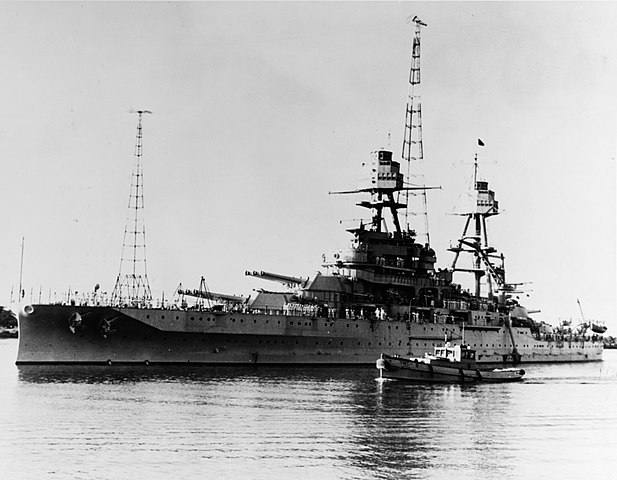
In pearl Harbor in 1932
In February, she headed for San Clemente in California and later participated in Fleet Problem XVIII, until 28 May. After a stop at Puget Sound until 3 September, she spent the rest of the year between San Pedro and San Francisco, taking part in Fleet Problem XIX until 30 April 1938 and a two-month cruise along the west coast until September. The next year she took part in Fleet Problem XX until February 1939 off Cuba, observed by Pdt. Franklin D. Roosevelt and Admiral William D. Leahy aboard Pennsylvania. She stopped at Culebra in February, and in March visited Port-au-Prince, Haiti, then Guantanamo Bay and US Naval Academy in Annapolis in April. She returned in Pacific to her San Pedro home port in May, followed by a west coast tour, from San Francisco, to Seattle and Hawaii for Fleet Problem XXI in April-May 1940, and in Hawaii until September, back to San Pedro and Puget Sound until 27 December for an overhaul where she she received four more 5-inch/25 AA guns. She was to take part in Fleet Problem XXII but by January 1941, the naval command cancelled it and instead ordered her to sail to Hawaii taking her place in the Pacific Fleet at Pearl Harbor. Apart a short trip to the west coast until October, this was now her new home port.
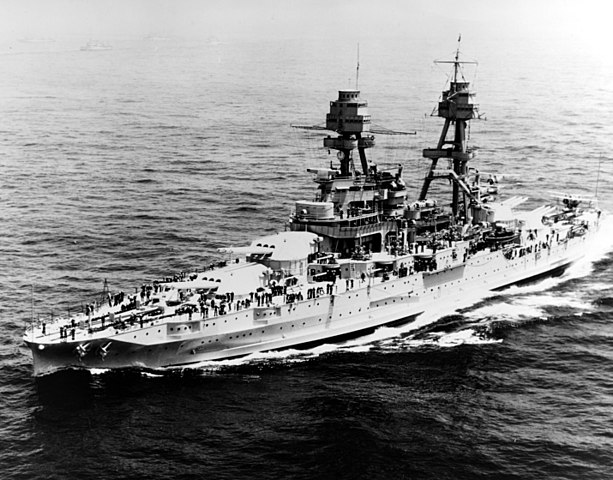
USS Pennsylvania in 1934
The Pearl Harbor Attack
On the morning of 7 December 1941, USS Pennsylvania was in fact in Dry Dock No. 1 at Pearl Harbor for a refit: A particular schedule that save her, although she could have been hit by bombs. At the time, her screw propellers were to be replaced, and she shared the large dock with the destroyers USS Cassin and Downes. When the air attack commenced, USS Pennsylvania’s crew went to their battle stations and anti-aircraft gunners started firing at the incoming wave. Her drydock posting did not dissuaded some reckless pilots of torpedo bombers to try to torpedo the side of the drydock to flood it. They all failed, but strafed the battleship instead. At 08:30, high-altitude bombers took the ship as target in turn and for fifteen minutes, several bombs fell, one hitting USS Downes and another passing through USS Pennsylvania’s boat deck, exploding in casemate No. 9. Despite all her anti-aircraft gunners furiously fired at the Japanese, none made a single hit. It was later established the main reason would have been possibly an incorrect fuse setup, made in the hit of battle. They claimed nevertheless on damaged and five down, but after post-battle enquiry, just two were awarded.
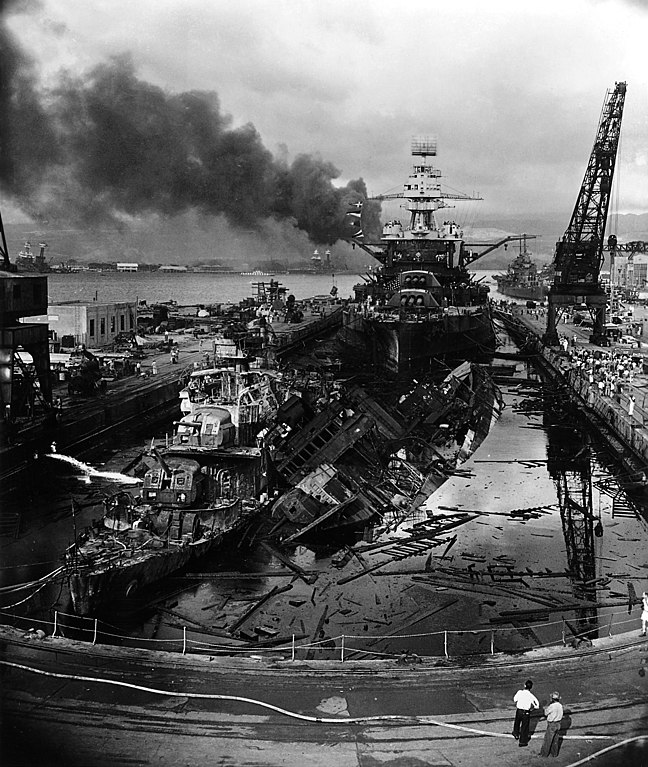
USS Pennsylvania, Downes and Cassin in Drydock Number one, Pearl Harbor, after the attack on 7 december
By 09:20, fire from the destroyers spread to Pennsylvania, and it was decided to flood the drydock to contain it, but this did not prevented both destroyers to eventually explode in turn, one of USS Downes torpedo tubes, spiralling into the air, stroked Pennsylvania’s forecastle. Her crew was busy combating flames at her bow, while anti-aircraft ammunition crates were more from the stores in West Loch. Fortunately, she escape the second wave, but lost in all 15 men, 14 were missing, and she had 38 wounded.
Around 14:00, repairs started already, and a 5-inch/25 gun AA and a 5-inch/51 casemate from West Virginia were bring out to repair those of the Pennsylvania. On 12 December, she was towed out of the drydock, ready to go to sea and she departed on 20 December to San Francisco, and in drydock at Hunter’s Point until 12 January.
Pennsylvania’s Pacific campaign
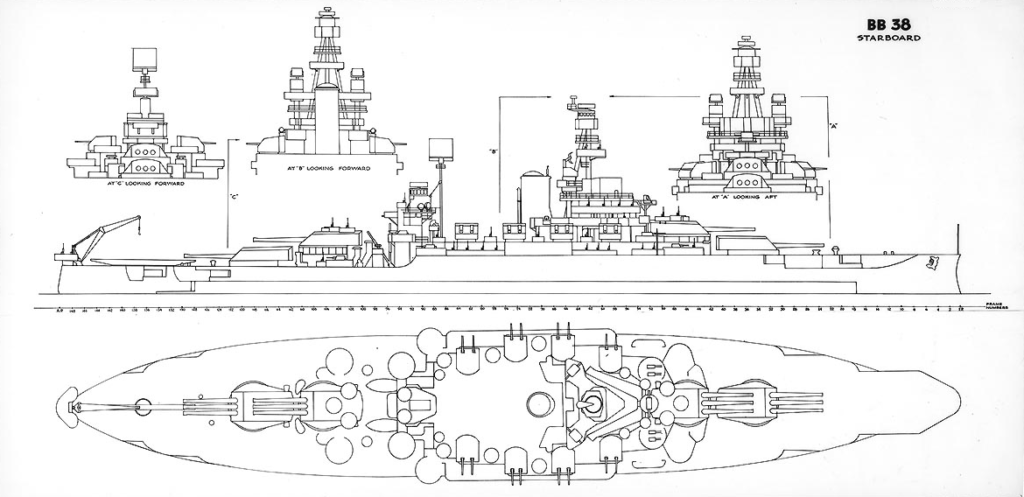
Pennsylvania’s last overhault and modernization, with a brand new AA battery and radar.
USS Pennsylvania was the only Battleship in the pacific ready for operations at that point. She left Francisco on 20 February for gunnery training, another session in March, and unil 1st August, extensive fleet manoeuvers off the coast of California, with an overhaul at Mare Island Naval Shipyard in between, where her AA battery was considerably reinforced by 10 Bofors 40 mm quad mounts, 51 Oerlikon 20 mm single mounts, tripod mainmast removed, new deckhouse aft and fitting of the brand new CXAM-1 radars above the cupola. Her secondary 5-in battery was replaced by fast 5-inch/38 cal eight twin mounts (16 total) capable of 4 rpm and AA fire. She was at sea during the Battle of Midway in Task Force 1 (Vice Admiral William S. Pye) as a backup.
The Aleutians (May-August 1943)
Her first active battle station was during the Aleutian and Makin atolls campaigns: On 1 August, USS Pennsylvania left San Francisco for Pearl Harbor, and after some training, she was overhauled in San Francisco until January 1943, trained off Long Beach in April, and joined the Aleutian Islands to shell Holtz Bay in May, supporting the assault of Attu. I-31 spotted her and launched a torpedo, spotted by passing-by PBY Catalina which altered Pennsylvania by radio, immediately taking evasive maneuvers. Two destroyers hunted her down and got her the next day. USS Pennsylvania supported another assault on the western side of the bay and operations went on until 19 May, before swapping to Adak Island. She suffered en route an accidental gasoline stowage explosion, and was detached to be repaired at Puget Sound until 15 June, suffering another accidental explosion. She returned in August 1943 to Adak, becoming flagship of Admiral Francis W. Rockwell, prepared to attack Kiska. The battleship then patrolled off Kiska before returning to Adak by 23 August and back to Pearl Harbor in September, and the took on board 790 passengers to San Francisco. She was back to Pearl Harbor on 6 October, training until 4 November.
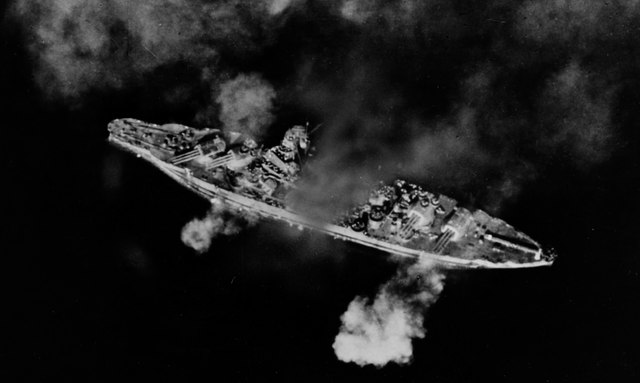
USS Pennsylvania Bombarding Guam
Makin (November 1943)
As flagship of Rear Admiral Richmond K. Turner, Fifth Amphibious Force (Northern Attack Force), USS Pennsylvania sailed out on 10 November to carry out the assault on Makin Atoll (Gilbert Islands) with three other battleships detached from the Atlantic fleet, four cruisers and three escort carriers and destroyers, plus the troopships fleet. The fleet arrived off Makin on 20 November. USS Pennsylvania opened fire on Butaritari at 14,200 yards, opening the Battle of Makin. On 24 November, off her starboard bow, the escort carrier Liscome Bay exploded, hit by a torpedo. night attacks of Japanese torpedo bombers 25-26 November failed hit the fleet however, and USS Pennsylvania left on 30 November to Pearl.
Marshalls campaign (February 1944)
In January 1944, Pennsylvania was in Pearl Harbor, training in preparation for the attack on Kwajalein in the Marshall. She departed on 22 January with the invasion fleet and was on site on 31 January, starting her shelling on the atoll. he went on supporting the assault and the whole Battle of Kwajalein. Marines eventually secured the island and Pennsylvanian left for Majuro Atoll, to resupply ammunition and was sent on 12 February to support the assault on Eniwetok and support infantry during the Battle of Eniwetok until 21 February and later on Parry Island.
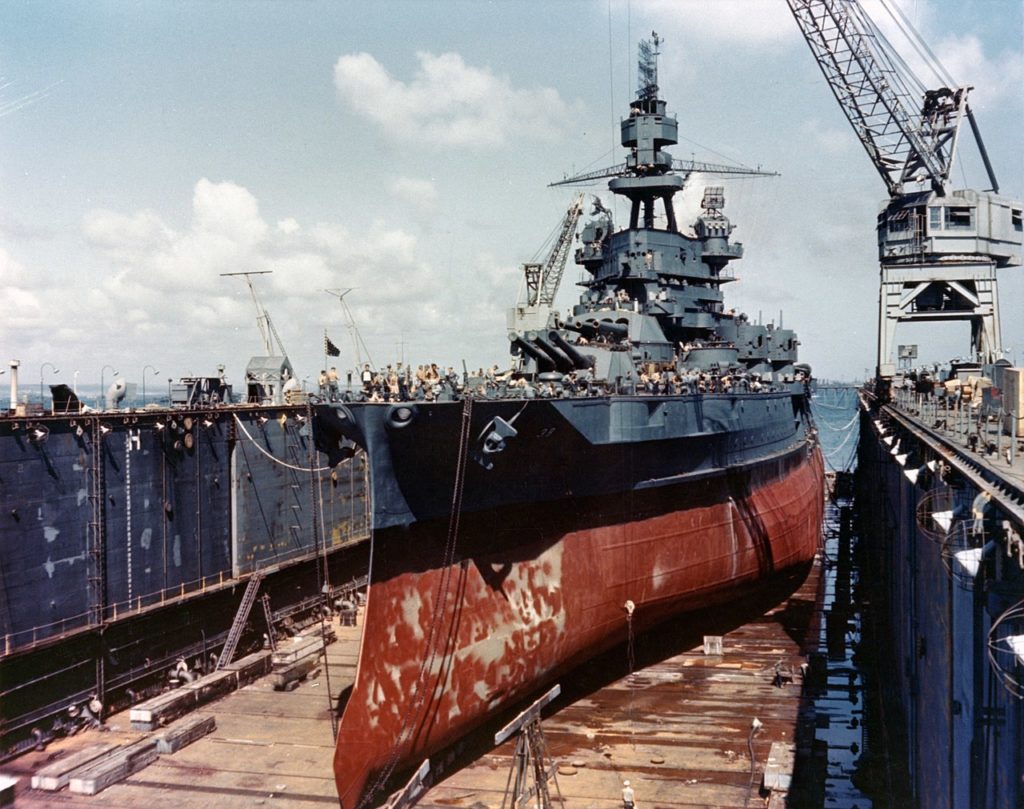
original color photo of USS Pennsylvania in a floating drydock in an advanced base in 1944
Marianas Campaign (June-July 1944)
In March, USS Pennsylvania as in Majuro, and after resupply, to Havannah Harbor (Efate Island) in the New Hebrides, until the 24. She left to visit Sydney until 11 May, back to Efate, then Port Purvis (Florida Island, Solomons) for amphibious assault support training and after supllying at Efate, she sailed for Roi on 2 June, joining the fleet assembled for the Marianas campaign, which took evasive maneuvers as a submarine was spotted during the night, but Pennsylvania collided with the troopship Talbot, only having minor damage while Talbot was sent to Eniwetok for emergency repairs. The shelling of Saipan started on 14 June, followed by the shelling of Tinian on 15 June, and Orote Point on Guam. She left to resupply on 25 June and resumed her shelling on Guam on 12 July. She resupplied then at Saipan and resumed her shelling until 20 July, dealing with fortifications and landing obstacles and off Orote Point until the assault craft attacked.
The Philippines Campaign (1944-1945)
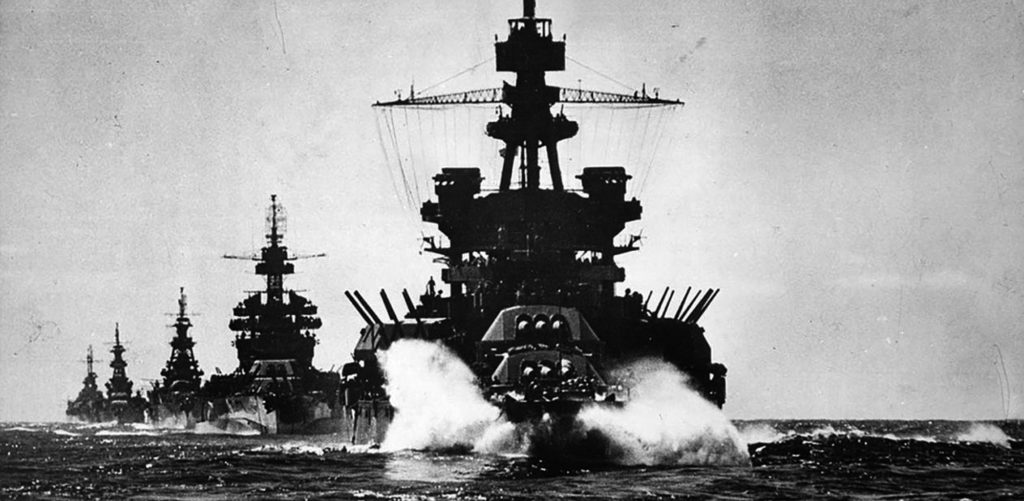
The Oldendorff’s quadron, led by USS Pennsylvania, followed by Colorado, Louisville, Portland and Columbia into Lingayen Gulf, January 1945.
USS Pennsylvania left Guam on 3 August for taking supplies at Eniwetok on 19 August, and sailed to Espiritu Santo, New Hebrides and off Guadalcanal in 6 September. After training she joined the Fire Support Group prepared to invade Peleliu. She started her bombardment on 12 September and supported landings, notably Anguar Island, until she left on 20 September, steaming to Seeadler Harbor on Manus islands (Admiralty Islands) for maintenance in a floating dry dock.
The Battle of Surigao Strait
She left on 12 October with USS Mississippi, Tennessee, California, Maryland, and West Virginia (Rear Admiral Jesse B. Oldendorf), as Task Group 77.2. This force was prepared to take part in the Philippines campaign, arriving off Leyte on 18 October. They first covered Underwater Demolition Teams and beach reconnaissance teams plus and minesweeping operations. On 24 October, reports were received of a Japanese naval force approaching and Oldendorf made ready his fleet for action, at the exit of the Surigao Strait.
Opposing, was Vice Admiral Shōji Nishimura, at the head of the Southern Force. He approached through the Surigao Strait to attack the invasion fleet in Leyte Gulf with a full Division headed by the battleships Yamashiro and Fusō, the cruiser Mogami and four destroyers, and Vice Admiral Kiyohide Shima’s Second Striking Force with the cruisers Nachi, Ashigara, Abukuma, and four destroyers, unaware of the presence of Oldendorff’s battleships. During the night of 24 October, PT boats fell on them, followed by destroyers. This was the start of the Battle of Surigao Strait. Fusō was disabled by a destroyer, but Nishimura went on, until dawn on 25 October, he spotted Oldendorf’s battle line, in perfect position to cross his T. At 03:53, USS West Virginia was the first to open fire, but Pennsylvania’s older Mark 3 radar failed to accurately spot the Japanese, delaying her fire. Ultimately this “duel” turned into an execution, Task Group 77.2’s battleships wiping out the IJN Battleship Division 2 while Shima’s Second Striking Force escaped. On 25 October, Pennsylvania’s AA gunners shot down four aircraft and on the 28, a torpedo bomber. She remained on station off Leyte until 25 November.
She headed for Manus, and Palau in December to refill and for gunnery training, spending Christmas here; On 1 January 1945, she was back with Oldendorf’s Fire Support Group, heading to Lingayen Gulf. On 4–5 January, Japanese air attacks went on, including kamikazes. They destroyed the carrier Ommaney Bay. Pennsylvania shelled Santiago Island (Lingayen Gulf entrance) on 6 January, and the operations in the gulf started, with shelling on 8-9 January, until the amphibious assault (6th US Army Force). Pennsylvanian repelled another air attack on 10 January, taking four near-misses. She also shelled and repelled a Japanese tank force leading a counter-offensive on the beachhead. She patrolled 10-17 January outside and in the gulf before departing on 10 February for maintenance at Manus, then San Francisco, via Pearl Harbor. On 13 March, she was drydock for her major wartime overhaul; Her worn-out main and secondary batteries were replaced while she received a more modern radar and fire control systems, plus and additional AA guns. She made sea trials off San Francisco and San Diego before departing on 12 July to Pearl Harbor. She was prepared there for the invasion at Okinawa.
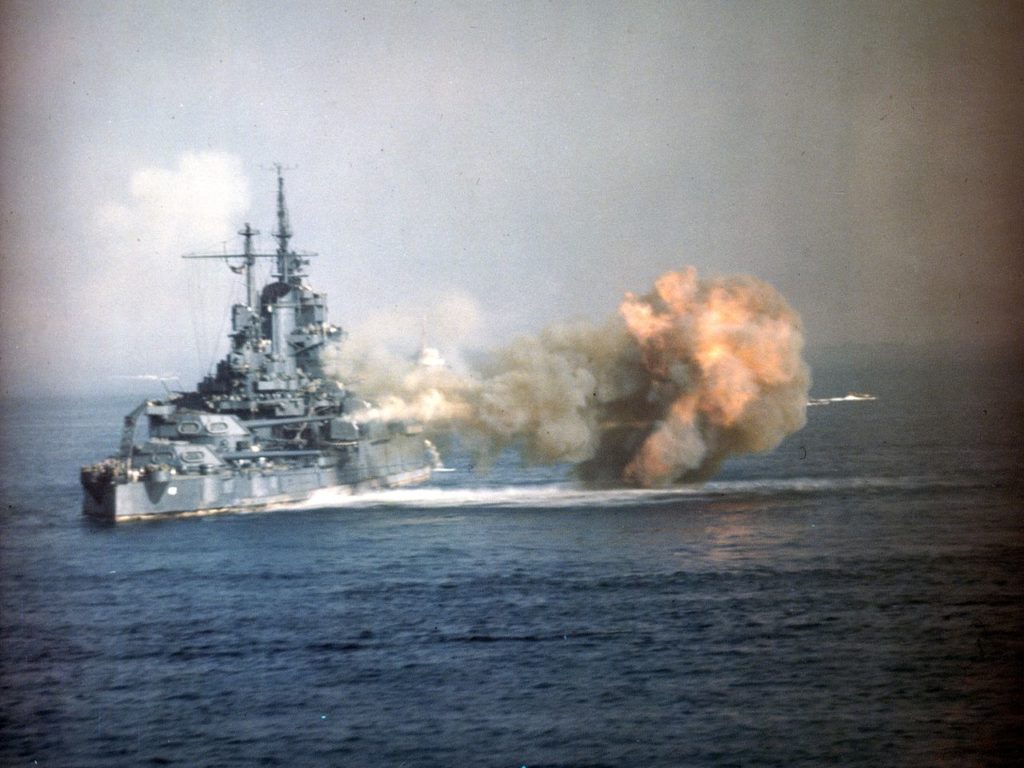
The Battle of Okinawa
USS Pennsylvania stopped en route to shell Wake Island on 1st August, silencing Japanese coastal guns, but being hit by fragments. One of her fire control directors was damaged. One of her Curtiss SC Seahawks was also lost in heavy seas but the pilot was recovered. USS Pennsylvania loaded ammunition at Saipan also en route to Okinawa. She was there on 12 August, taking command as flagship of Task Force 95, moored next to USS Tennessee in Buckner Bay. There, she was attacked by a Japanese torpedo bomber, which, undetected, launched its torpedoes and hit her aft. A hole circa 30 larged cause serious flooding, so much so the battleship started to settle by the stern. Damage was controlled however by the teams, which contained the flooding, but Twenty men had been drown or killed int the explosion, ten more injured, including Admiral Oldendorf himself, aboard when it happen. USS Pennsylvania was in fact the last major US warship to be damaged in WW2. She was salvaged by tugs and conducted to shallow water for temporary repairs. On 15 August, surrender was claimed, and she was taken in tow on 18 August to Apra Harbor in Guam for more repairs. The war was over for the Battleship, but her fate was not enviable as she was a guinea pig for the new atomic era.
The end of pennsylvania
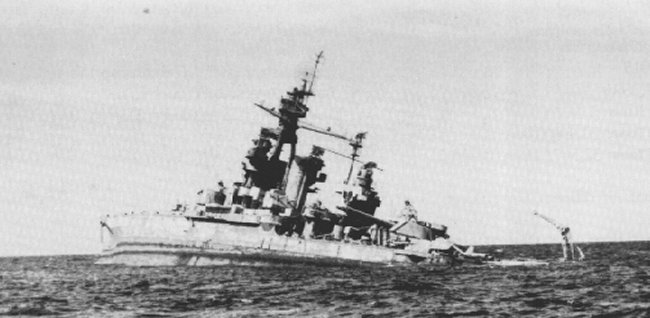
USS Pennsylvania sinking off Kwajalein in 1948
After repairs in a floating drydock in September, patched over the torpedo hole, she was relieved by USS Missouri as flagship on 15 September and departed on 2 October to Puget Sound for further repairs, escorted by USS Atlanta. On 17 October one of her propeller shaft slipped aft and she stopped that divers could cut the shaft loose, so USS Pennsylvania was left to one operational propeller screw while the other emptied open propeller shaft was blocked, but still water leaked into the compartment. She arrived on 24 October to Puget Sound, and a ceremony awarded the ship for for her wartime service on 3 November. On 16 January 1946, she had been repaired, but received the new she would be chosen to serve as a target ship for Operation Crossroads at Bikini Atoll. She sailed to the Marshall on 24 February via Pearl Harbor and arrived in the Bikini Atoll on 31 May 1946, anchored with eighty-three warships. Test Able on 1 July was air burst that damaged her superstructures and contamined her. Her remaining crew was evacuated on 24 July seo she was empty on Test Baker the next day, an underwater detonation. The old battleship was by then just 1,100 yards (1,000 m) from ground zero, but was only lightly damaged from the blast. She was prepared on 21 August to be towed by Niagara to Kwajalein, decommissioned on 29 August, studied and eventually scuttled off Kwajalein on 10 February 1948, stricken on 19 February. Her bell survived and two of her 14-inch guns are on display at the Pennsylvania Military Museum in Boalsburg.


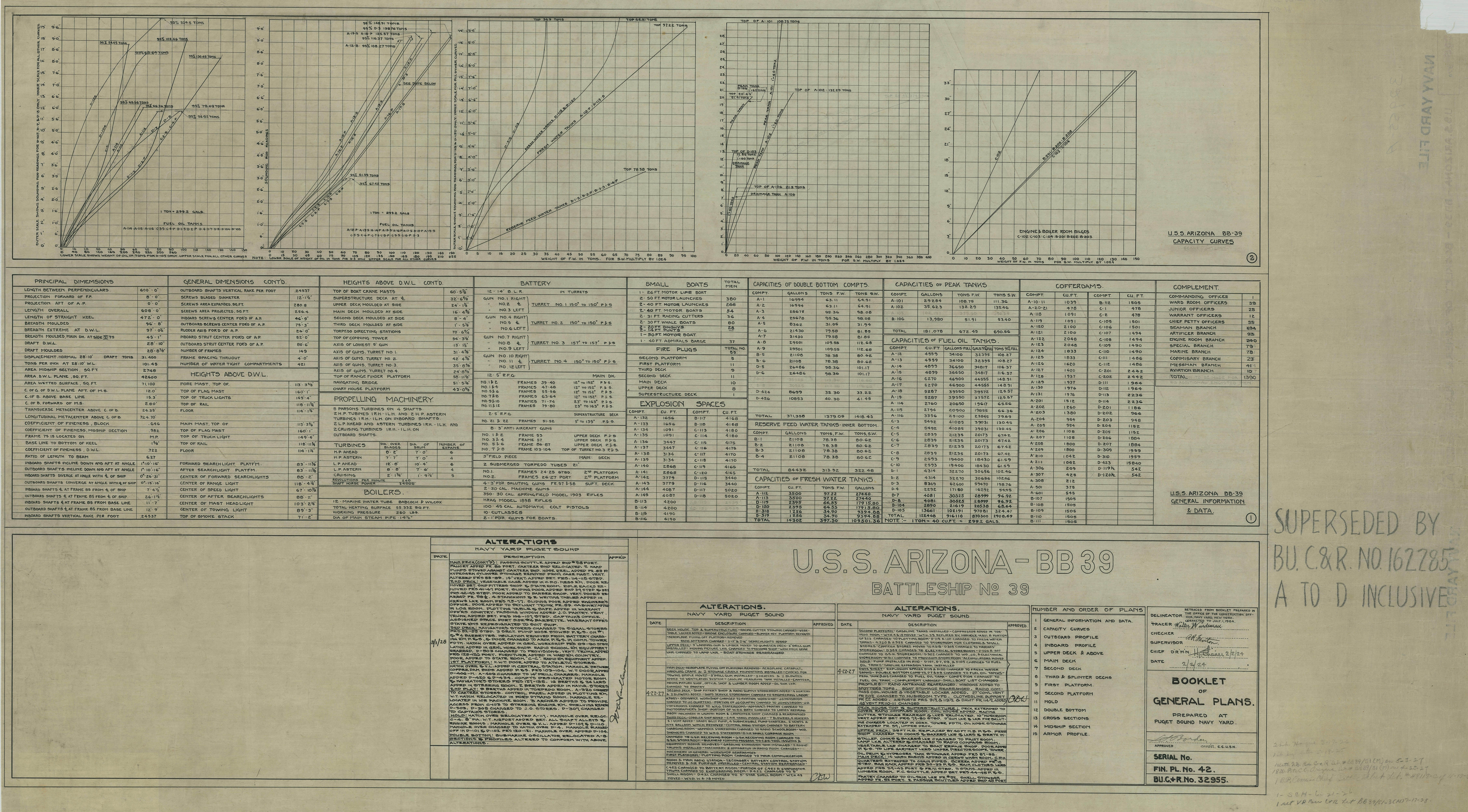
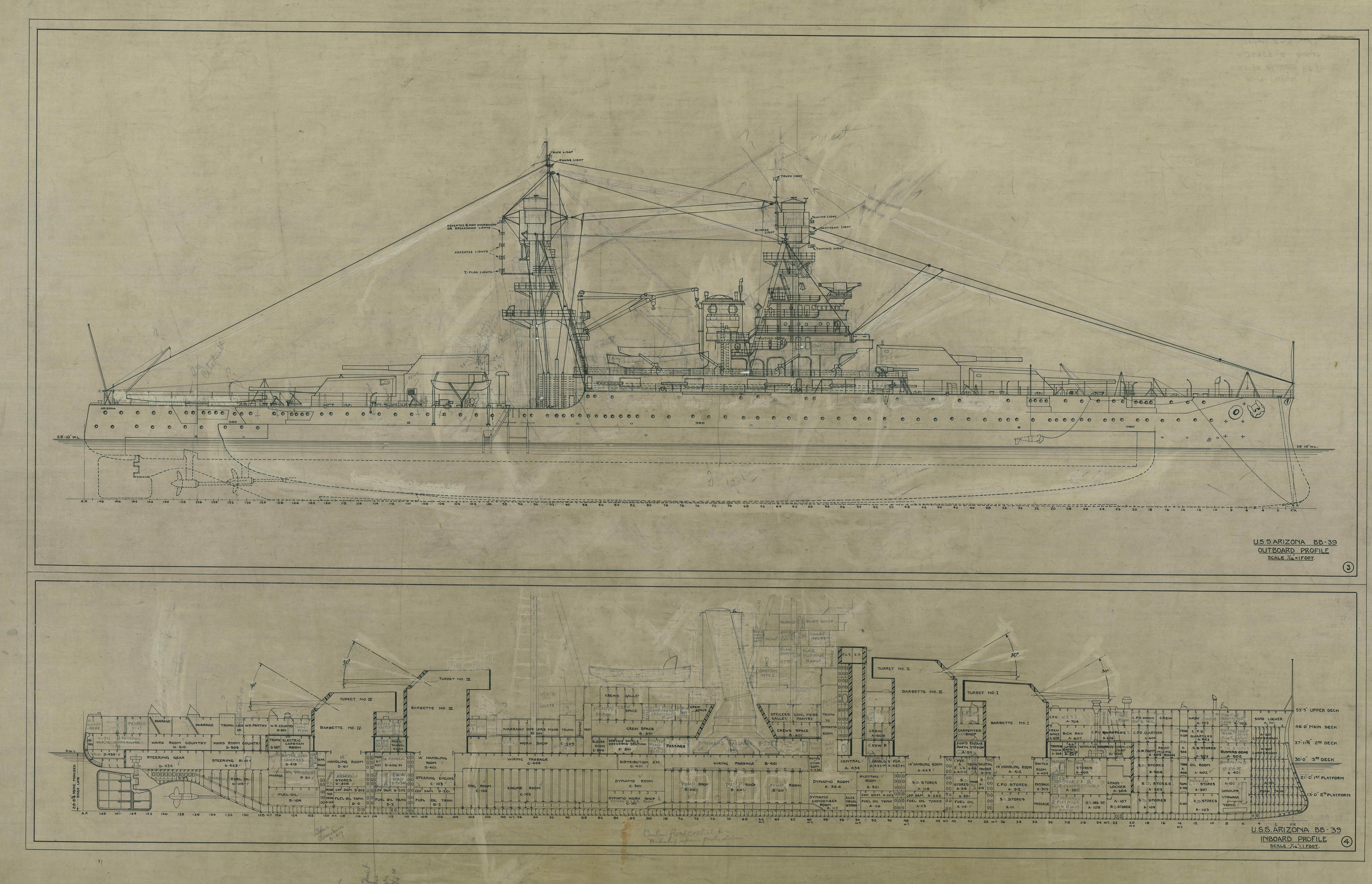
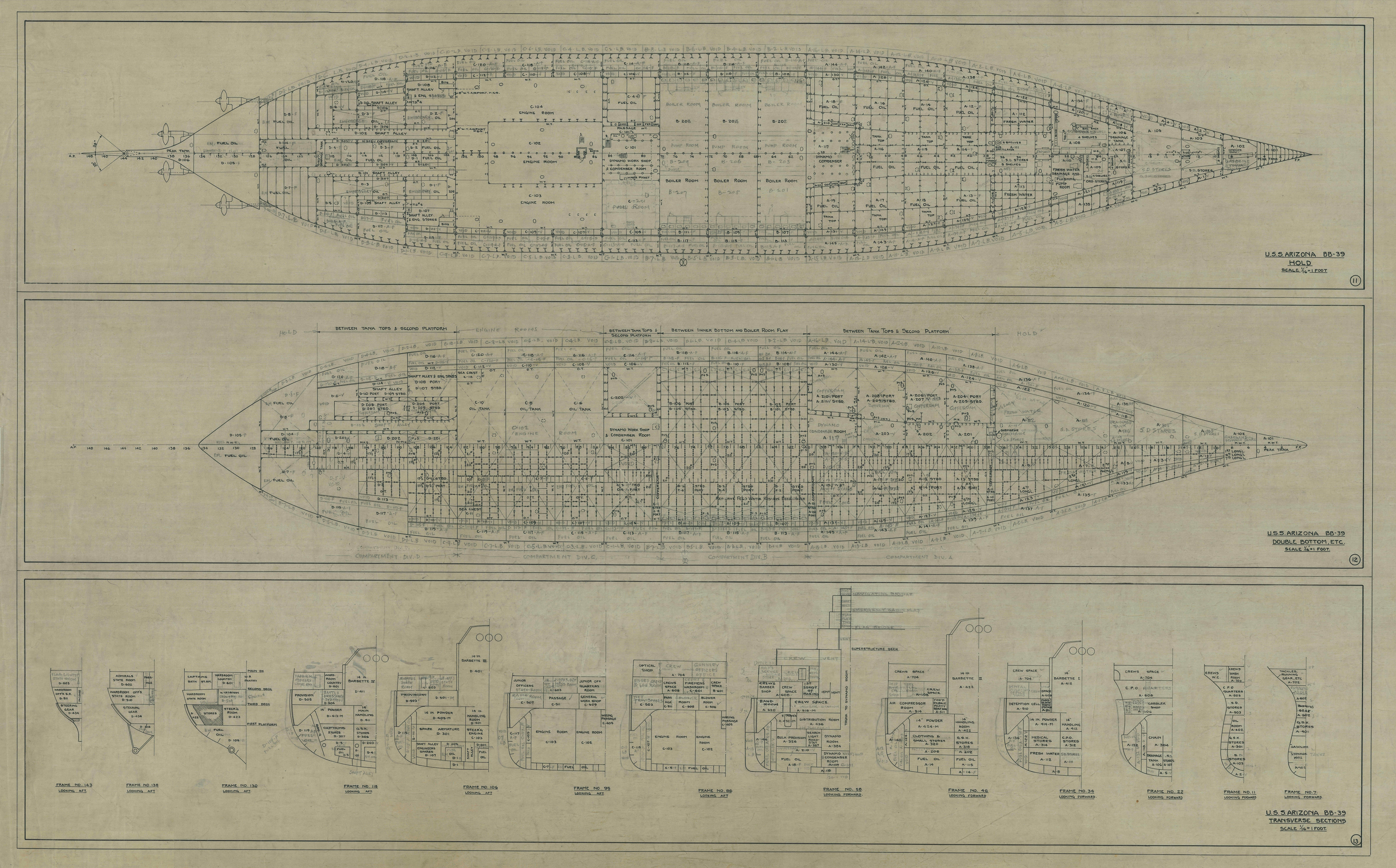
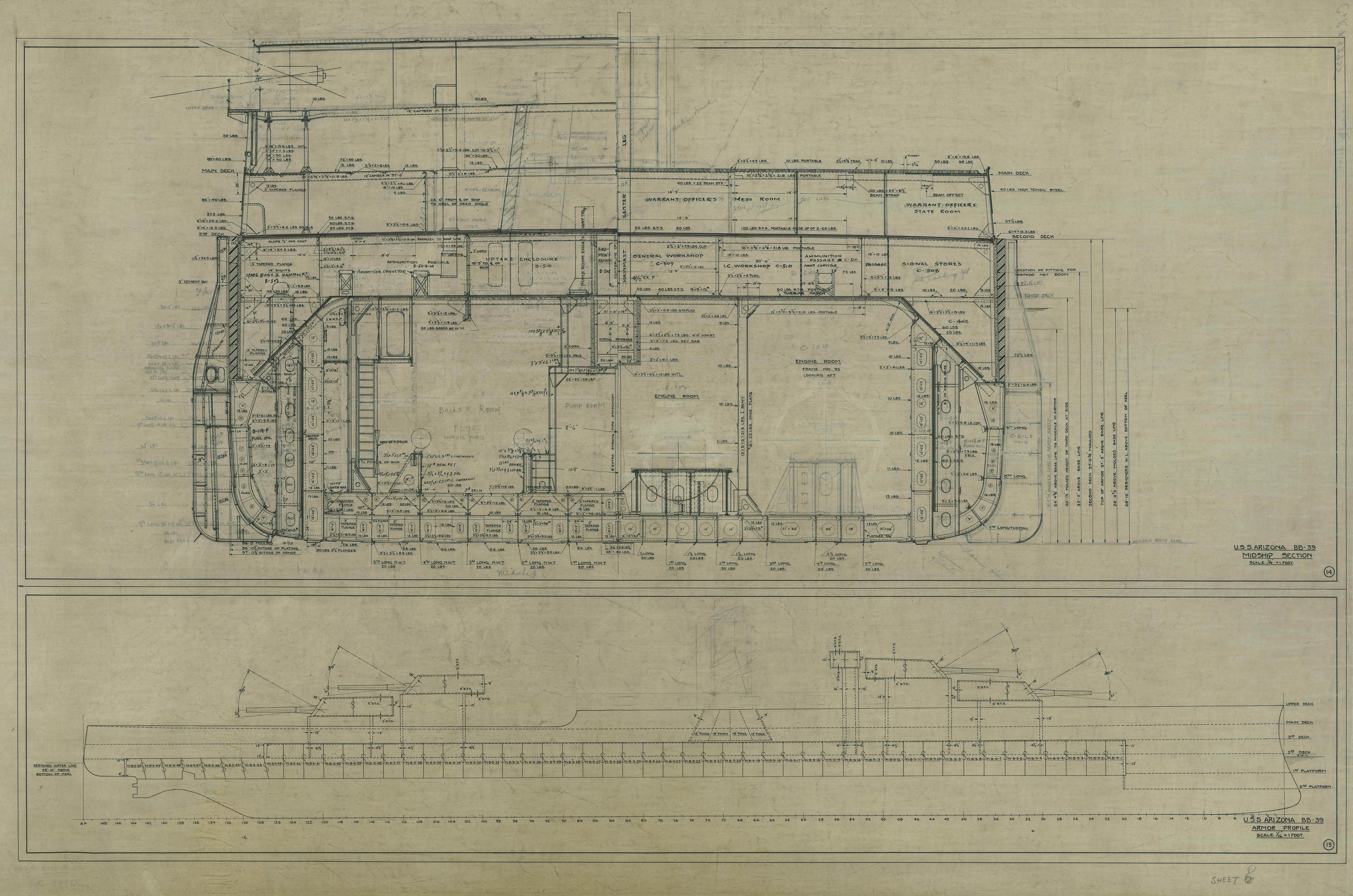
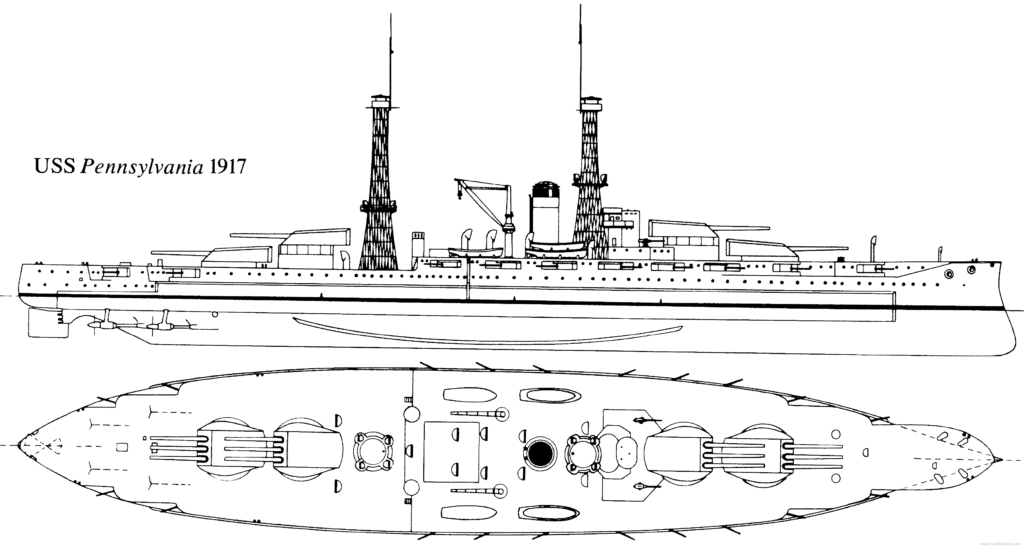
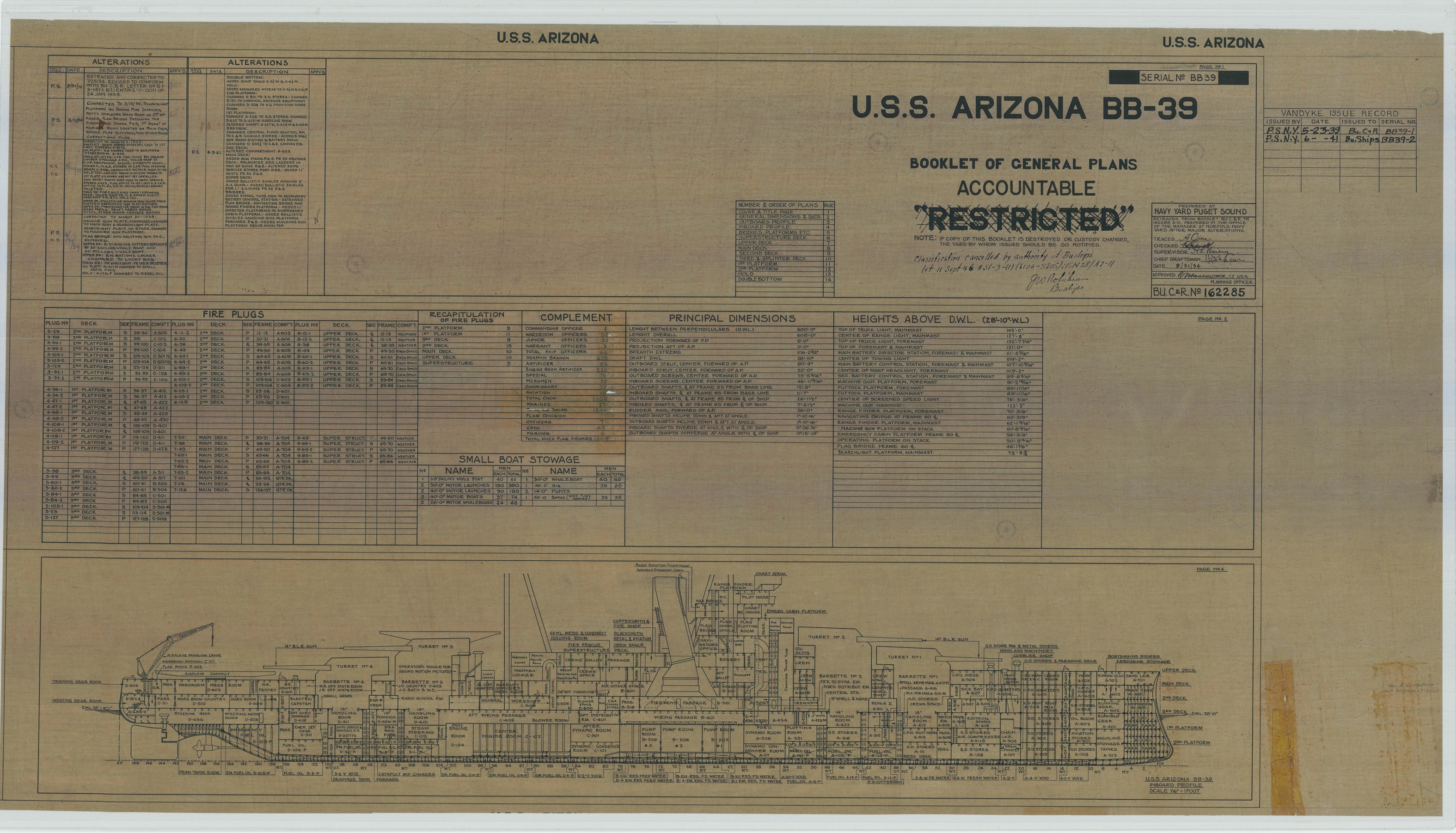
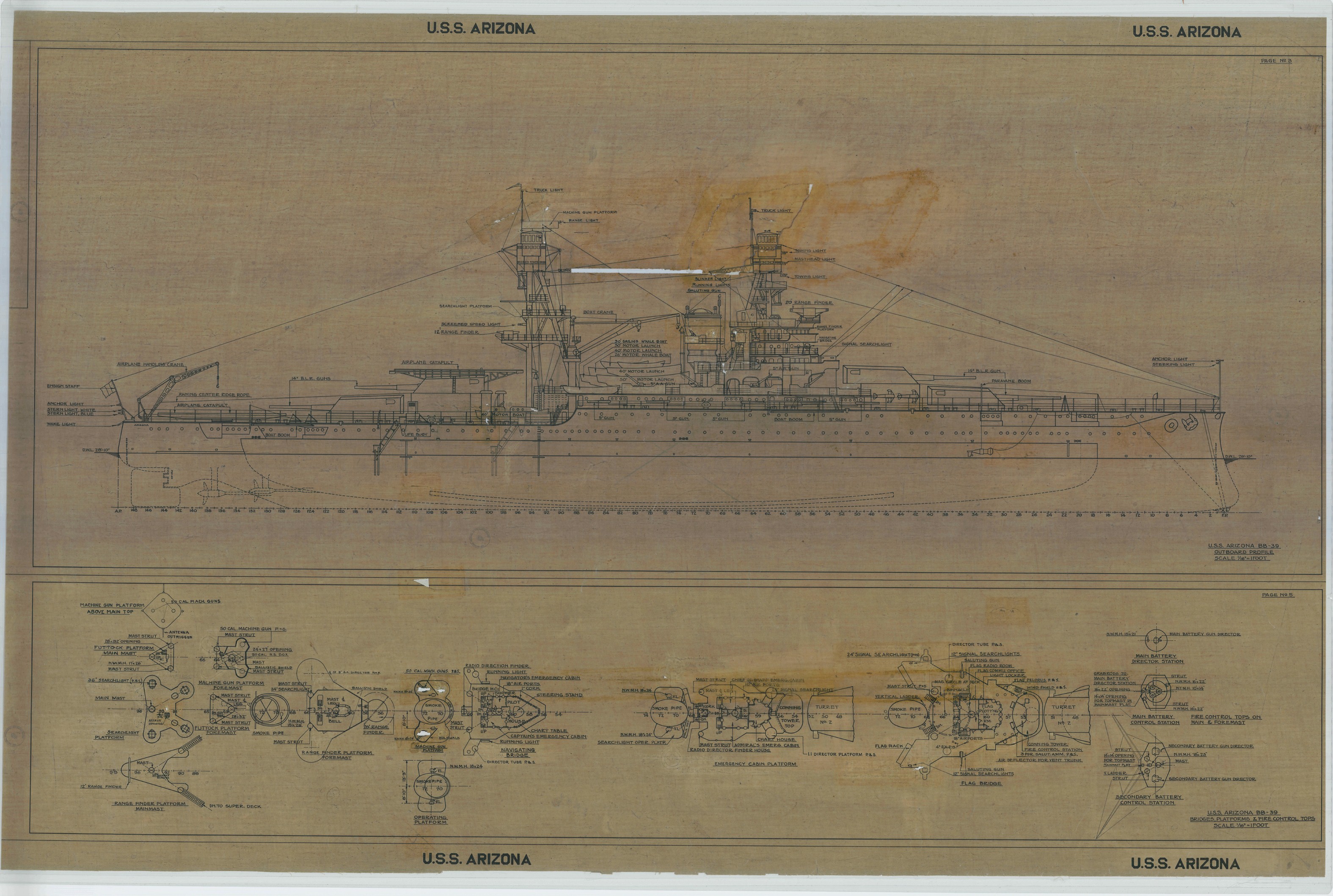
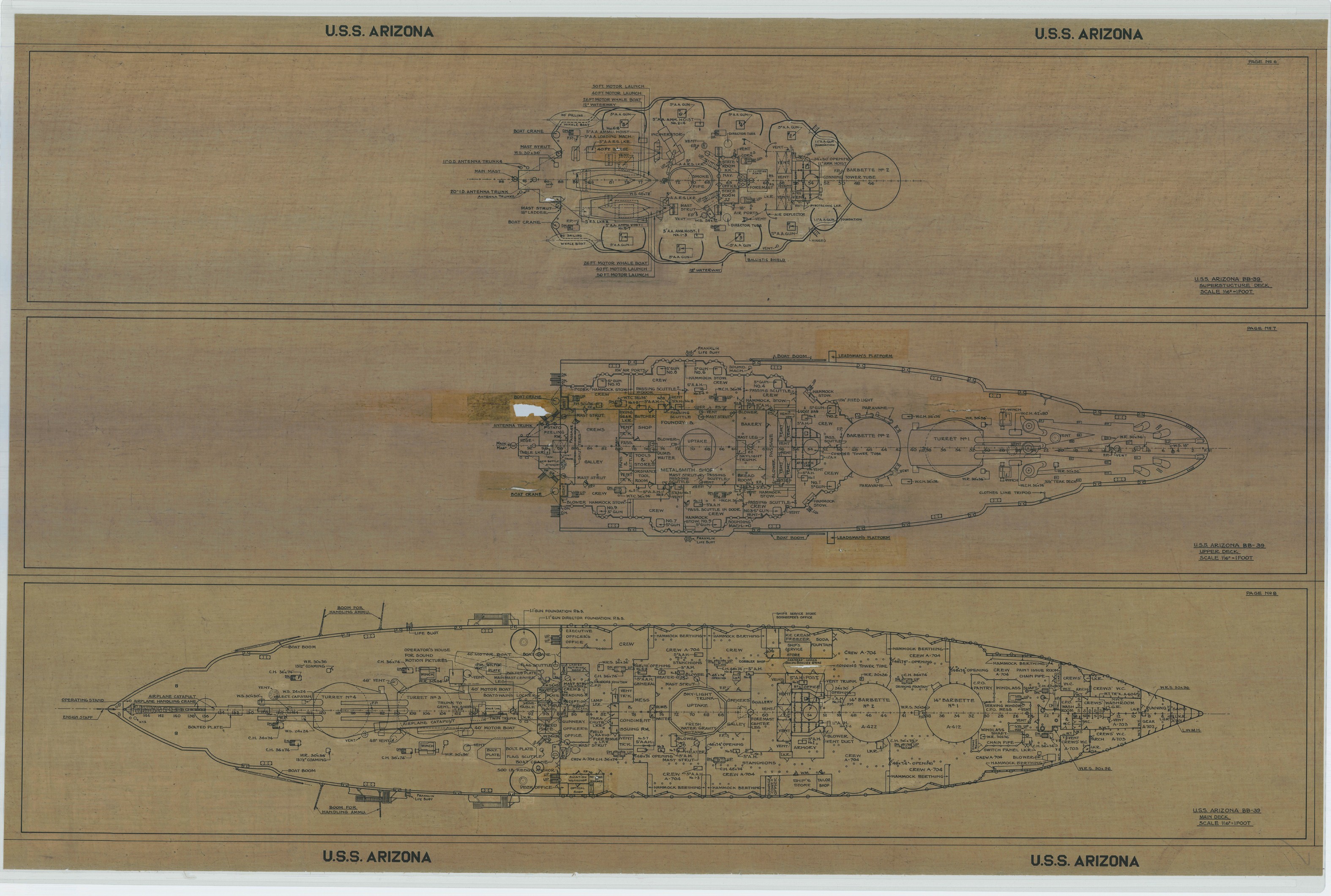
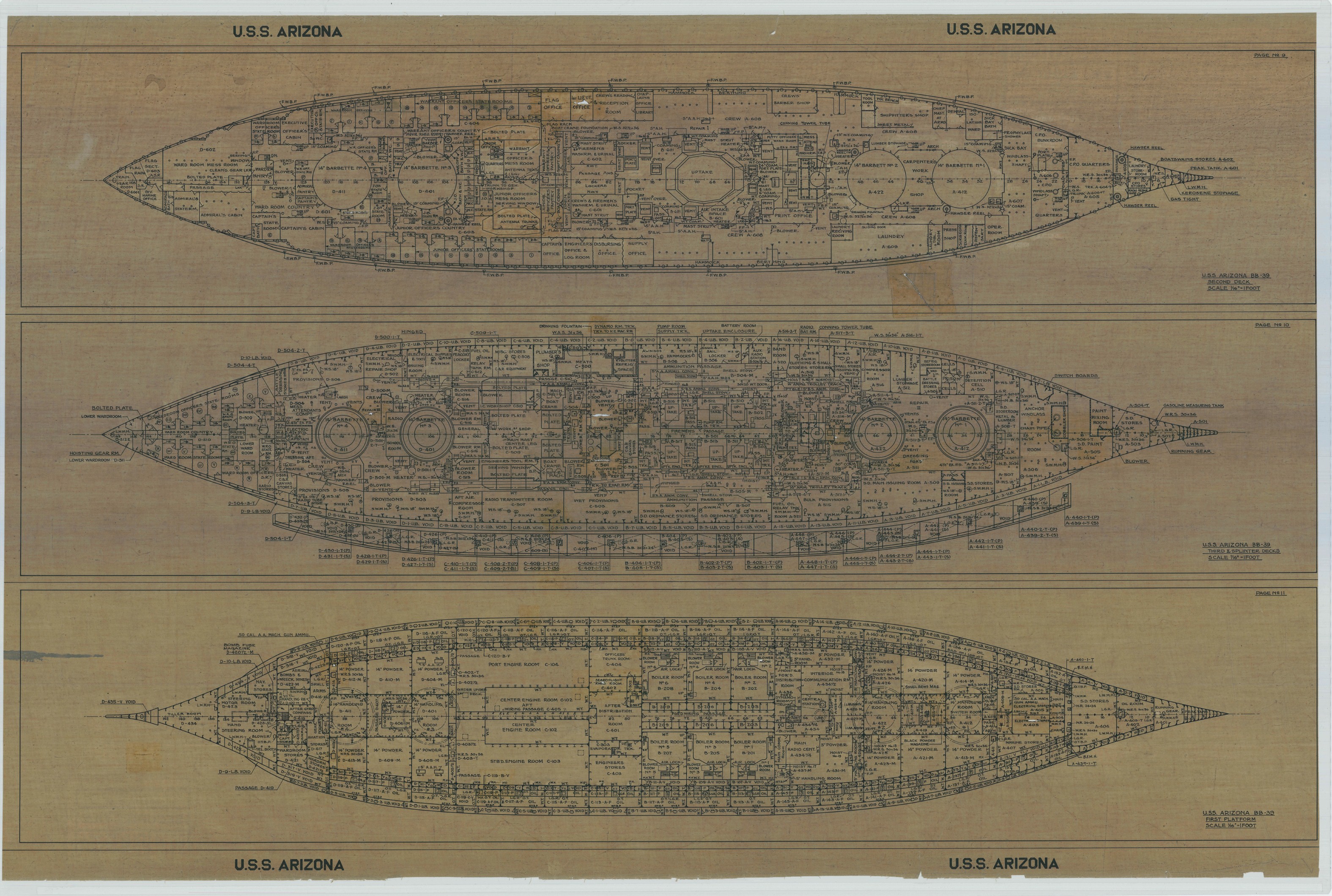
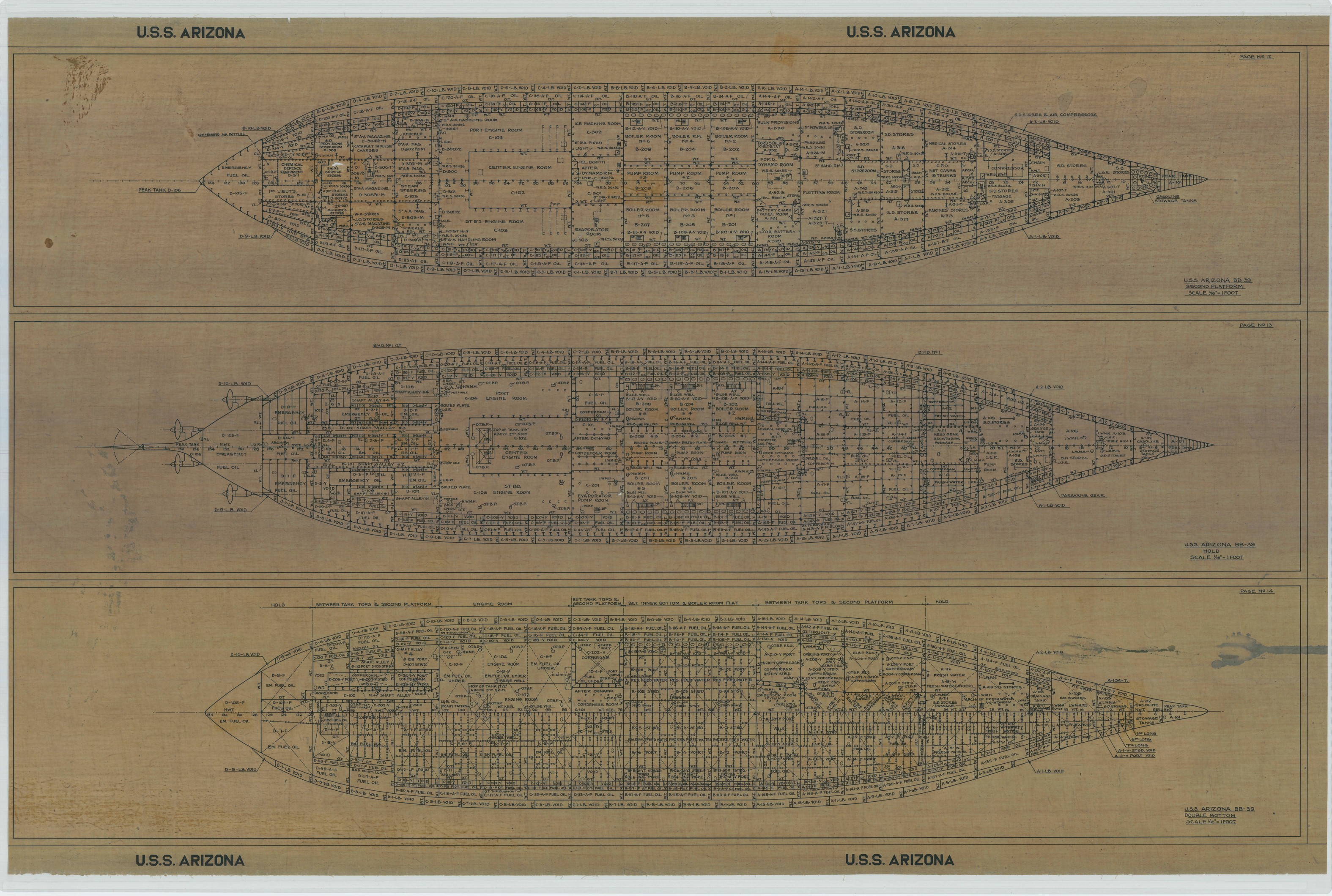
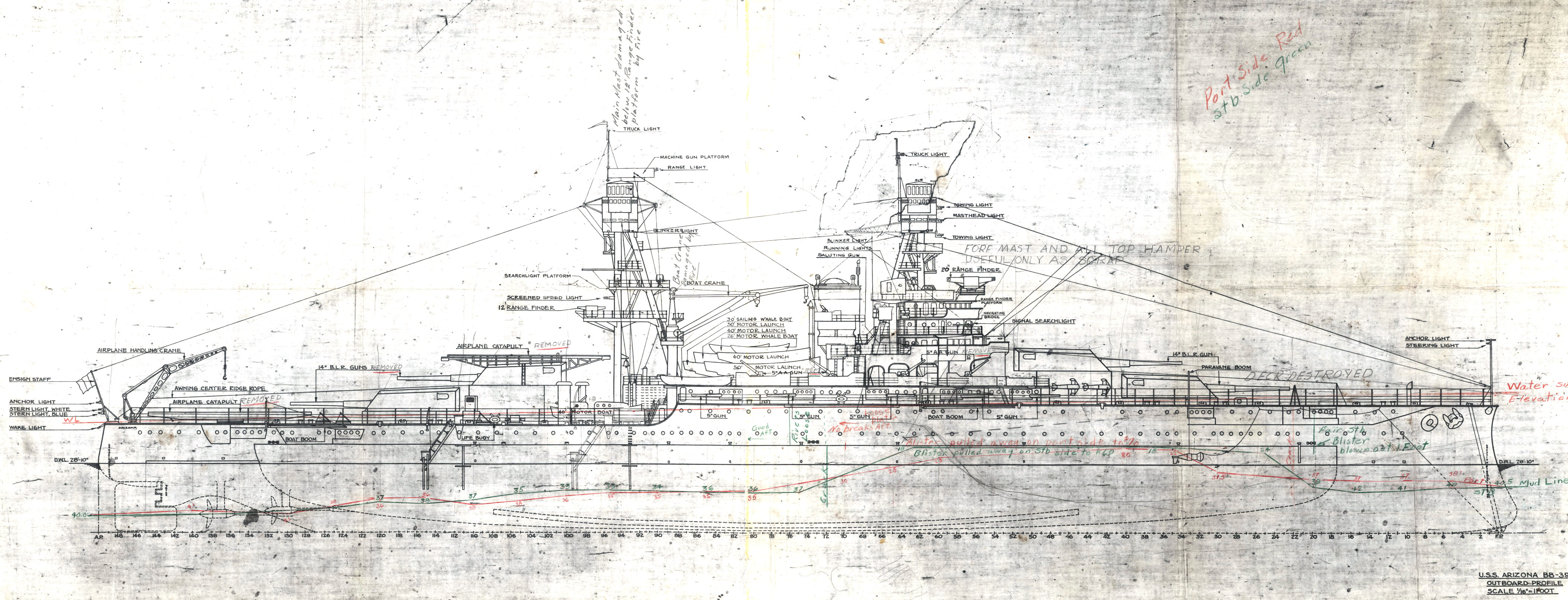
 Latest Facebook Entry -
Latest Facebook Entry -  X(Tweeter) Naval Encyclopedia's deck archive
X(Tweeter) Naval Encyclopedia's deck archive Instagram (@navalencyc)
Instagram (@navalencyc)





 French Navy
French Navy Royal Navy
Royal Navy Russian Navy
Russian Navy Armada Espanola
Armada Espanola Austrian Navy
Austrian Navy K.u.K. Kriegsmarine
K.u.K. Kriegsmarine Dansk Marine
Dansk Marine Nautiko Hellenon
Nautiko Hellenon Koninklije Marine 1870
Koninklije Marine 1870 Marinha do Brasil
Marinha do Brasil Osmanlı Donanması
Osmanlı Donanması Marina Do Peru
Marina Do Peru Marinha do Portugal
Marinha do Portugal Regia Marina 1870
Regia Marina 1870 Nihhon Kaigun 1870
Nihhon Kaigun 1870 Preußische Marine 1870
Preußische Marine 1870 Russkiy Flot 1870
Russkiy Flot 1870 Svenska marinen
Svenska marinen Søværnet
Søværnet Union Navy
Union Navy Confederate Navy
Confederate Navy Armada de Argentina
Armada de Argentina Imperial Chinese Navy
Imperial Chinese Navy Marinha do Portugal
Marinha do Portugal Mexico
Mexico Kaiserliche Marine
Kaiserliche Marine 1898 US Navy
1898 US Navy Sovietskiy Flot
Sovietskiy Flot Royal Canadian Navy
Royal Canadian Navy Royal Australian Navy
Royal Australian Navy RNZN Fleet
RNZN Fleet Chinese Navy 1937
Chinese Navy 1937 Kriegsmarine
Kriegsmarine Chilean Navy
Chilean Navy Danish Navy
Danish Navy Finnish Navy
Finnish Navy Hellenic Navy
Hellenic Navy Polish Navy
Polish Navy Romanian Navy
Romanian Navy Turkish Navy
Turkish Navy Royal Yugoslav Navy
Royal Yugoslav Navy Royal Thai Navy
Royal Thai Navy Minor Navies
Minor Navies Albania
Albania Austria
Austria Belgium
Belgium Columbia
Columbia Costa Rica
Costa Rica Cuba
Cuba Czechoslovakia
Czechoslovakia Dominican Republic
Dominican Republic Haiti
Haiti Hungary
Hungary Honduras
Honduras Estonia
Estonia Iceland
Iceland Eire
Eire Equador
Equador Iran
Iran Iraq
Iraq Latvia
Latvia Liberia
Liberia Lithuania
Lithuania Mandchukuo
Mandchukuo Morocco
Morocco Nicaragua
Nicaragua Persia
Persia San Salvador
San Salvador Sarawak
Sarawak Uruguay
Uruguay Venezuela
Venezuela Zanzibar
Zanzibar Warsaw Pact Navies
Warsaw Pact Navies Bulgaria
Bulgaria Hungary
Hungary

 Bundesmarine
Bundesmarine Dutch Navy
Dutch Navy Hellenic Navy
Hellenic Navy Marina Militare
Marina Militare Yugoslav Navy
Yugoslav Navy Chinese Navy
Chinese Navy Indian Navy
Indian Navy Indonesian Navy
Indonesian Navy JMSDF
JMSDF North Korean Navy
North Korean Navy Pakistani Navy
Pakistani Navy Philippines Navy
Philippines Navy ROKN
ROKN Rep. of Singapore Navy
Rep. of Singapore Navy Taiwanese Navy
Taiwanese Navy IDF Navy
IDF Navy Saudi Navy
Saudi Navy Royal New Zealand Navy
Royal New Zealand Navy Egyptian Navy
Egyptian Navy South African Navy
South African Navy






























 Ukrainian Navy
Ukrainian Navy dbodesign
dbodesign
Hello! Just a small typo in the beginning I assume. New Mexico and Tennesse were built during WW1 not WW2.
Yes it is, thx for spotting !